MAXWELL COFFEE HOUSE (HILLS BROS. COFFEE HOUSE (& COFFEE GARDEN & AMERICAN EGG HOUSE)
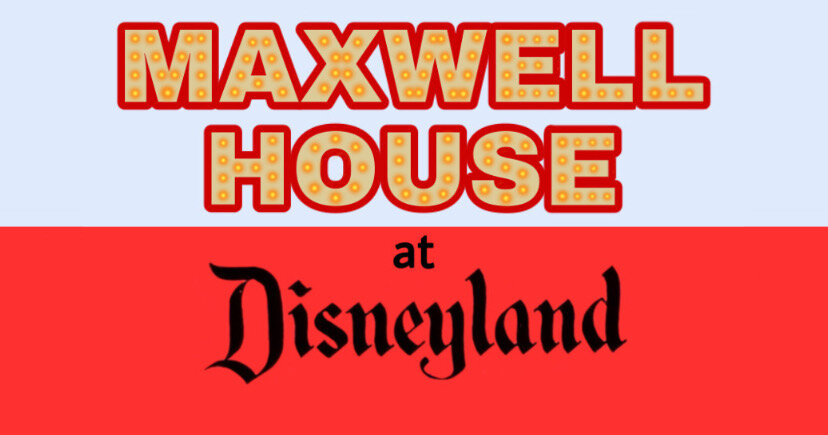
(December 1, 1955 - October 8, 1957)
“Let’s dine at Disneyland,” on the 600 block of Main Street U.S.A.), in Town Square at Disneyland® Park!
“Participant Sponsorship”
Our story begins in 1951, when Walt Disney and Art Linkletter visited the famous entertainment complex Tivoli Gardens in Copenhagen. He was researching and talking notes to build a family entertainment center and Tivoli was much like what he envisioned. It was clean, directed to the entire family, fun, entertaining and educational. Walt noted how important it was to have a lot of places for guests to sit down and a wide variety of eating spots that served excellent meals.
Fast forward to 1954 when Walt was searching for participants to lease shop and restaurant spaces at Disneyland, and help generate the necessary capital to fund construction of Disneyland. In a synergistic relationship, the companies (in turn) could sell their products and advertise their corporate names in the Park. Disneyland Participant Corporate Sponsors were carefully selected. High quality, long term corporate sponsors would provide incremental income that enabled Disneyland to enhance its show and attractions, offset some operating expenses, and capitalize on marketing opportunities.
Several of these turn-of-the-century pioneers, “reliable old firms” sponsored the “abundance of restaurants devoted to pleasing all tastes and all budgets,” according to “The Story of Disneyland,” published 1955. Ultimately, Maxwell Coffee House Division of General Foods became one of those forty-seven lessees to sign a contract with Walt Disney Productions (regarding creating happiness at Walt Disney’s Disneyland)!
It was estimated that the table service facility would have the capacity to serve about 400 guests per hour. Despite the fact that Maxwell Coffee House Restaurant did not open in July of 1955, it became reckoned among Disneyland’s twenty eating facilities which were predicted to contribute to accommodating “15,000 persons daily, hitting a peak of 60,000 o holidays and week-ends…” and one of “twenty restaurants and snack bars, capable of saving 8,000 hourly,” at least according to “Building A Dream” (prepared by the Disneyland, Inc. Public Relations Department). Years later in 1958, Bank of America appraisers figured of the total income received from leases, 16.02% was derived from the selling of advertising rights and 40.12% from the leasing of space to concerns whose main reason for occupancy is for advertising purposes. The remaining 43.86% of the lease income was derived from stores that sell various products and food. It is this income that supported the construction and growth of Disneyland. Clearly, these participant corporate sponsors were not here to make money, but to create happiness!
“Initial Concept Designs by Disneyland, Inc.”
According to “THE DISNEY THEME SHOW - an introduction to the art of Disney outdoor entertainment: Volume II”: Of all the guests’ senses that come into play at Disneyland, the most difficult response to predict was taste. If 70,000 guests were to arrive on a single day, there would probably be 70,000 different ideas about food. Generally speaking, Disneyland food locations fall into three categories - sit-down restaurant service, “buffeteria,” and fast-food categories. The most extensive theming has always been found in the sit-down restaurant locations but all locations were housed in authentically motified facilities.
As Walt described to Bob Thomas (of Associated Press), “some industries will have exhibits, but all of them must be in keeping with the era.” Soon (c. 1954-1955), Sam McKim (with audiences in mind) and possibly other contributing artists were creating designs for the Maxwell Coffee House Restaurant Show Building Facade. This building would camouflage a construction wall.
Early thumbnail sketches and other concept artwork of Disneyland seemed to be unencumbered by restrictions of budget, schedule or the laws of nature and physics. Though guided by Walt, his artists appeared to engage in “free-thinking,” as if implementing the modern “Blue Sky” Imagineering process. Like some advanced “High Concept,” final designs were quickly generated and approved.
Next, architectural drawings helped define all designs, production and construction strategies, costs, schedule, and resource requirements. “Disneyland is unique in that some of the world's foremost creative artists and architects control all design at Disneyland.“ Models explored the various dimensional relationships, site-lines, flow patterns, ergonomics, and visual appeal to convey the desired creative intent.
“Architectural Designs by Lessees”
Disneyland, Inc. printed materials for Lessees detailing specifications for architectural designs of exhibit spaces. These were revised by March 16, 1955 and issued to Lessees.
All of the interior architectural drawings were done by competent registered architects or an approved display house of the lessee's choice. All of the designs submitted by the lessee's architect, whether for buildings or construction of interiors in DISNEYLAND, were approved as to the theme and general plan of DISNEYLAND as established by WED Enterprises, Inc.
Three sets of preliminary drawings were furnished DISNEYLAND, Inc. as soon as possible after signing of the lease. Two sets were retained by DISNEYLAND and one set was returned to the lessee’s architect with any revisions noted thereon and stamped “APPROVAL TO PROCEED TO FINAL DESIGN.” This stamp when properly signed and dated constituted the lessee’s authority to proceed with the final drawings.
The Lessees revised their final drawings to incorporate any revisions noted on the approved preliminary drawings, and submitted three sets of the revised drawings to DISNEYLAND. One set was returned to the lessee’s architect and any revisions noted thereon are to be incorporated on the original drawings. When the lessee had incorporated the final revisions on the drawings, two sets of transparent ozalids were forwarded to DISNEYLAND for approval. DISNEYLAND would stamp both sets “FINAL DESIGN APPROVED” and “LESSEE’S CONTRACT DRAWINGS”, and return one set to the lessee who could then release drawings for bid and/or construction.

“Construction”
“When the giant earth-moving undertaking was completed, the building crews took over. Soon, the rat-tat-tat of riveters was shattering the air, and sparks were flying from welders’ torches as the steel frameworks, capable of withstanding the ravages of time and the elements rose above the newly formed ground. While carpenters hammered and masons laid row upon row of brick and stone and mortar, the permanent buildings began to take shape and form,” according to “The Disneyland Story” published 1955. One of the first buildings to be constructed was the Main Street Opera House, which was used as the Mill. Here, the woodwork of Disneyland was generated - from the functional to the aesthetic! Approximately three and one-half million board feet of lumber went into the Park’s construction. Much of the wood was processed here by McNeil Construction (which formerly constructed Walt Disney Studio sound stages in 1947 and 1953), and under the direction of George Mills Sr. (the Prime General Contractor and Mill Foreman).
Then, under the direction of Joe Fowler (Construction Supervisor), as well as Charles Alexander and Ray Conway (Construction Field Supervisors), the lumber was soon fashioned into the framing belonging to the very first buildings constructed at Disneyland - primarily the Main Street Complexes (on each side of the street).
In constructing each building, a concrete foundation and slab floors were prepared, followed by wood frame construction (while store units would have a combination wood and rigid steel frame). ”The first fabricated steel for the Main Street buildings arrived November 8 and was erected,” according to the narrator of “Disneyland - The Park,” a Disneyland anthology television series excerpt, first aired 1957 and Disneyland LINE (November 22, 1979). The roof covering was a variable, dependent on the architectural design.
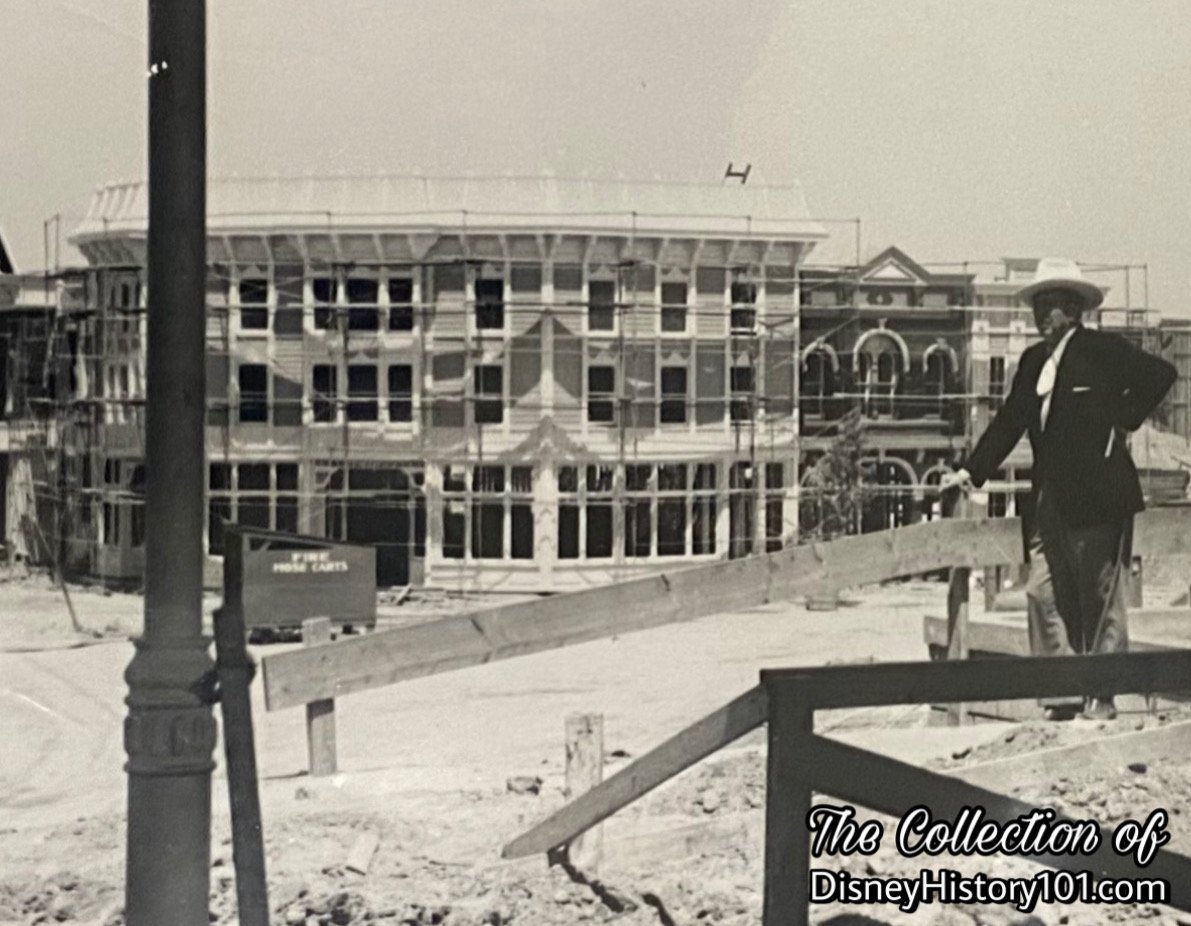
While Walt Disney stands framed by the covered waiting room of the Disneyland railroad station note the Coffee House under construction; World Wide Photo 6892-aje-6/9/55
As of June 2, 1955, C.V. Wood Jr. sent an Inter-Office Memorandum to Walt Disney regarding the best estimates that could be obtained at the time regarding the completion status of individual sections of the Park and Opening Day. C.V. wrote: “Building #612 - Maxwell House. Will not be completed. We will have to dress. Electric Signs: All are in work - with the exception of the shoe store and the Bank of America, all will be completed.“
The building (as each on Main Street U.S.A.) possessed complete fire sprinkling systems. By June 30, 1955, related Disneyland Site Work Fire Protection Utilities Plot Plans were prepared for Disneyland Inc., by J.E. Thomasson of WED Enterprises Inc.
All fixtures were placed in their correct motif and many light fixtures of Disneyland were authentic antiques. The Disneyland News added: “From its wrought iron and old stonework exterior to the patio-type serving area, the Maxwell House represents all that was fine and gracious in turn-of-the-century life in the New Orleans section of the Old South. Built to resemble a hotel of that time and place, it offers a jewel-like lobby sumptuously dec orated with crystal chandeliers and velvet and plush furnishings. Past the lobby is the intimate coffee shop, serving coffee and pastries. Although indoors, the coffee shop ceiling fades away to a midnight blue and stars twinkle above.”
The wrought iron work and staff work was also performed right on the jobsite by Lawrence G. and Bruce McNeil’s forces.
Food service equipment was provided by Coast Distributing Company of Los Angeles (who ran a “Congratulations” message to Walt Disney and Staff in “The Disneyland News”, Vol. 1, No.2 ; August 10, 1955).
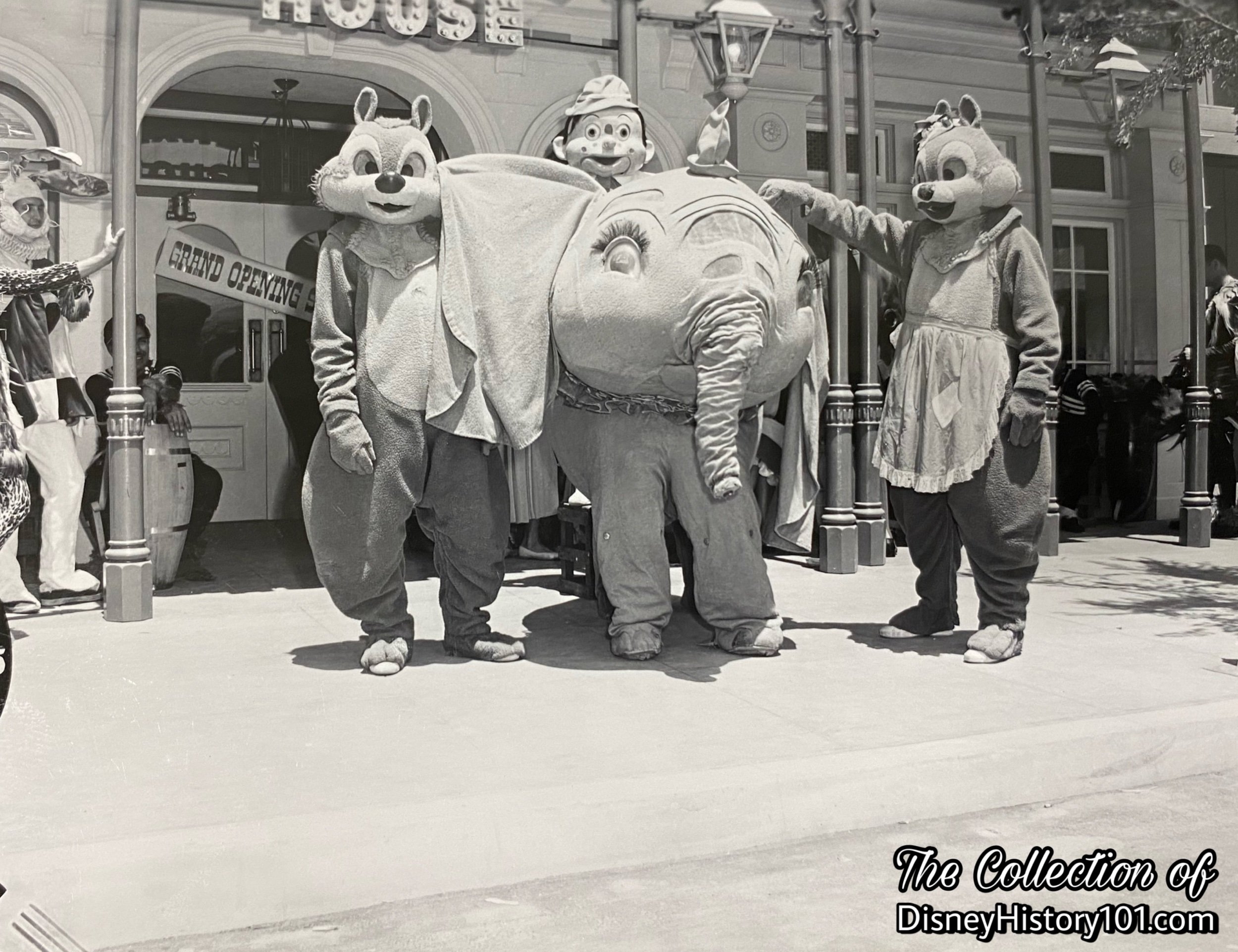
Note the Maxwell House Grand Opening signs behind the Disney Characters; © Walt Disney Company.
“The Press Preview Day of Disneyland”
Bob Milek recalled: “Opening day was very exciting...a big parade with movie stars…and I took pictures from the roof of Hills Bros.” But Maxwell Coffee House was not ready by July 17, 1955. Disneyland Mill Foreman Scotty Cribbes remembered: “On opening day, I was walking down Main Street with a cup of coffee in each hand, when I ran into Walt Disney. Walt stopped me and I thought I was going to be fired, but Walt just wanted to know where HE could get a cup of coffee!”
In the meantime there were several places that served Maxwell House coffee. In a move of corporate synergy, the fabulous Disneyland exclusively served Maxwell House Coffee at 16 eating locations (i.e. Aunt Jemima’s Kitchen, UPT Food Stands, Carnation Ice Cream Parlor, Chicken Plantation, Railroad Station, Red Wagon Inn, Space Bar, Pirate Ship, Frito House, and the Tropical Saloon, to name but a few). The price for a cup of coffee? Maynard Swenson recalled that “Coffee was 5¢ a cup then!”
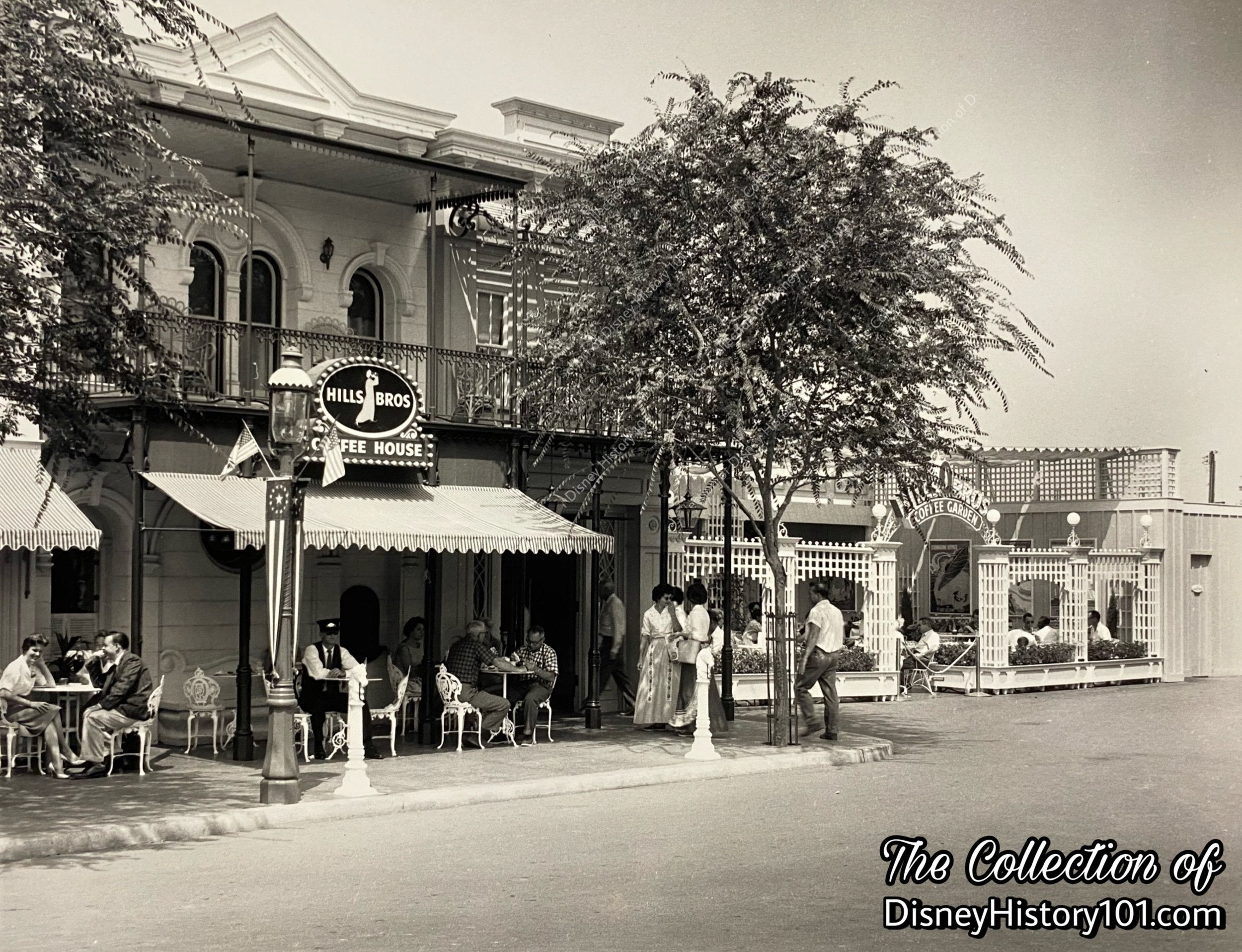
The Maxwell House Restaurant Front of House depicted in one press release photograph; ©️ Walt Disney Productions.
“The Maxwell Coffee House Grand Opening”
After Disneyland opened, the Disneyland News (of August, 1955) began advertising a Maxwell House opening soon in Disneyland. One advertisement (published in The Disneyland News, September 1955, page 22) announced that the Maxwell House would open soon on Main Street U.S.A.! It would be a few more months before the official opening occurred on December 1st, 1955, to “all the excitement of a Hollywood premier,” with “celebrities from the business and entertainment world” joining Walt Disney and Russell Kramer, General Manager of the Institutional Products Division of General Foods! “Some 1000 American Hotel Association conventioners were also on hand to mark the event, guests of General Foods and Maxwell House for the evening.” According to another headline added, “Televisions stars Eve Arden (‘Our Miss Brooks’), Spring Byington, and Dean Miller (‘December Bride’) were on hand to assist with the opening.”
Guests had the opportunity to meet “The Greatest Guy In The World, the Man Who Takes His Family Out to Dine, central figure in General Foods’ national advertising - the most dramatic promotion in the history of the food service industry,” according to The Disneyland News (Vol.1 -No.6 ; published December 10, 1955).
Marcy Smothers (in her book “Eat Like Walt - The Wonderful World of Disney Food”) adds that Walt attended “though he had a terrible case of laryngitis. Despite buckets of rain, the cancellation of the planned parade, and the postponement of Walt’s award as the ‘Greatest Guy In The World’, the dedication ceremonies in Town Square went off without a hitch. Following the ceremonies, two hundred of the Guests boarded the train at the Main Street Station for the brief ride to the Frontierland Station, while others followed the Disneyland Band to the Plaza. Everyone came together again for dinner and entertainment at the Chicken Plantation Restaurant. Maxwell House VIPs were then treated to an after-party at the Red Wagon Inn.”
The story “New Maxwell House Graces Main Street” covering the opening of the new Maxwell Coffee House (and the full-page advertisement “Maxwell House Welcomes American Hotel Association”) were both published in The Disneyland News (Vol.1 -No.6 ; for December 10, 1955).
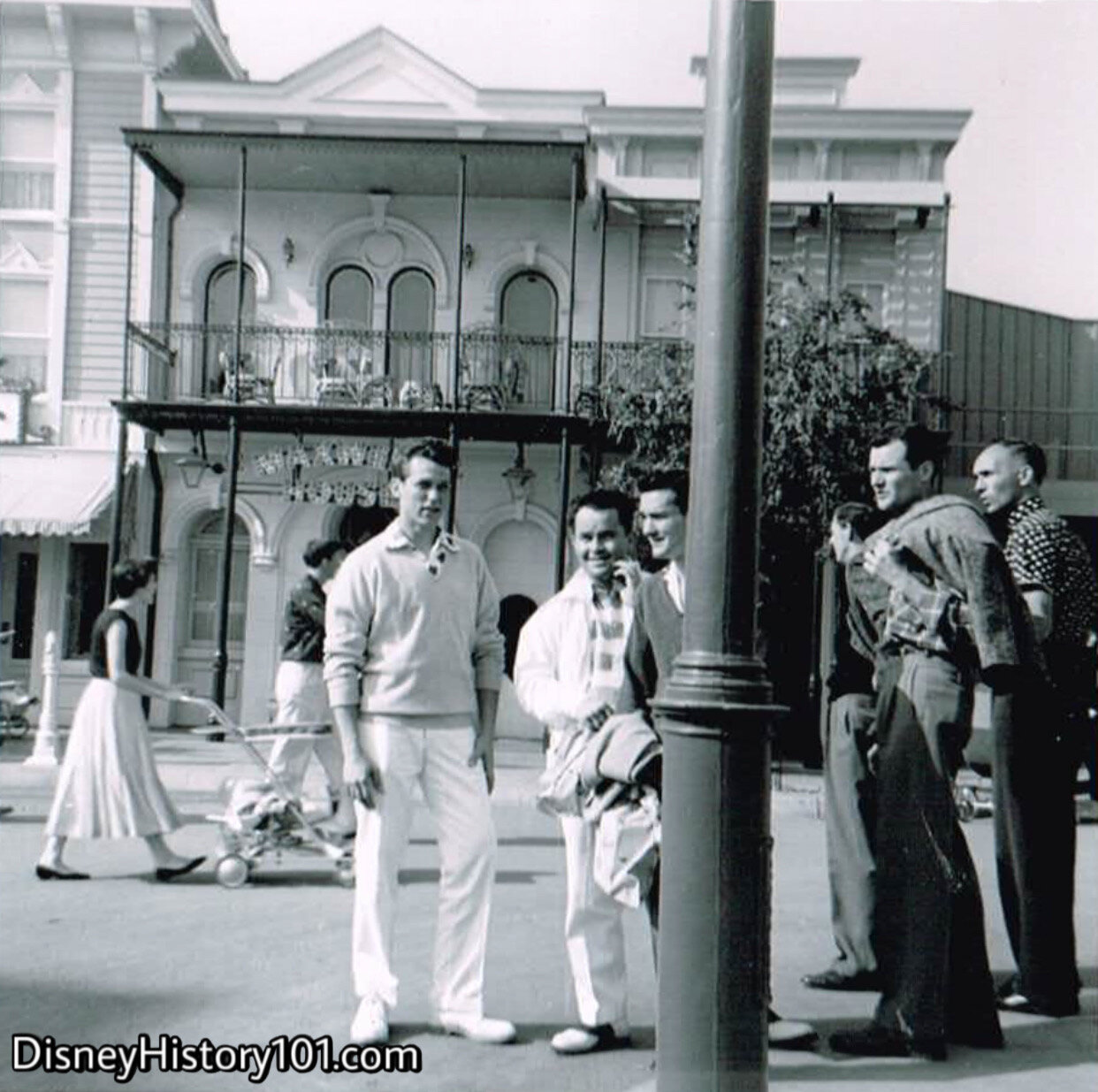
Guests pose for a photograph near the Maxwell House Restaurant. Note the cresting and railing, possibly from plantations of Memphis and Nashville.
Now, Maxwell House Restaurant became the prime table-service restaurant of two Town Square locations where guests would to “tarry for a moment’s relaxation” before the rest of the Park opened in the morning, and enjoy a delicious cup of “good ‘til the last drop” Maxwell House Coffee (with superior flavor, aroma, and body)!
After setting foot inside the “turn-of-the-century hotel lobby, complete with an authentic registration desk,” guests “may choose a table in the starlight dining room, or be seated on the open-air patio,” according to “Food Showmanship Disney Style.”
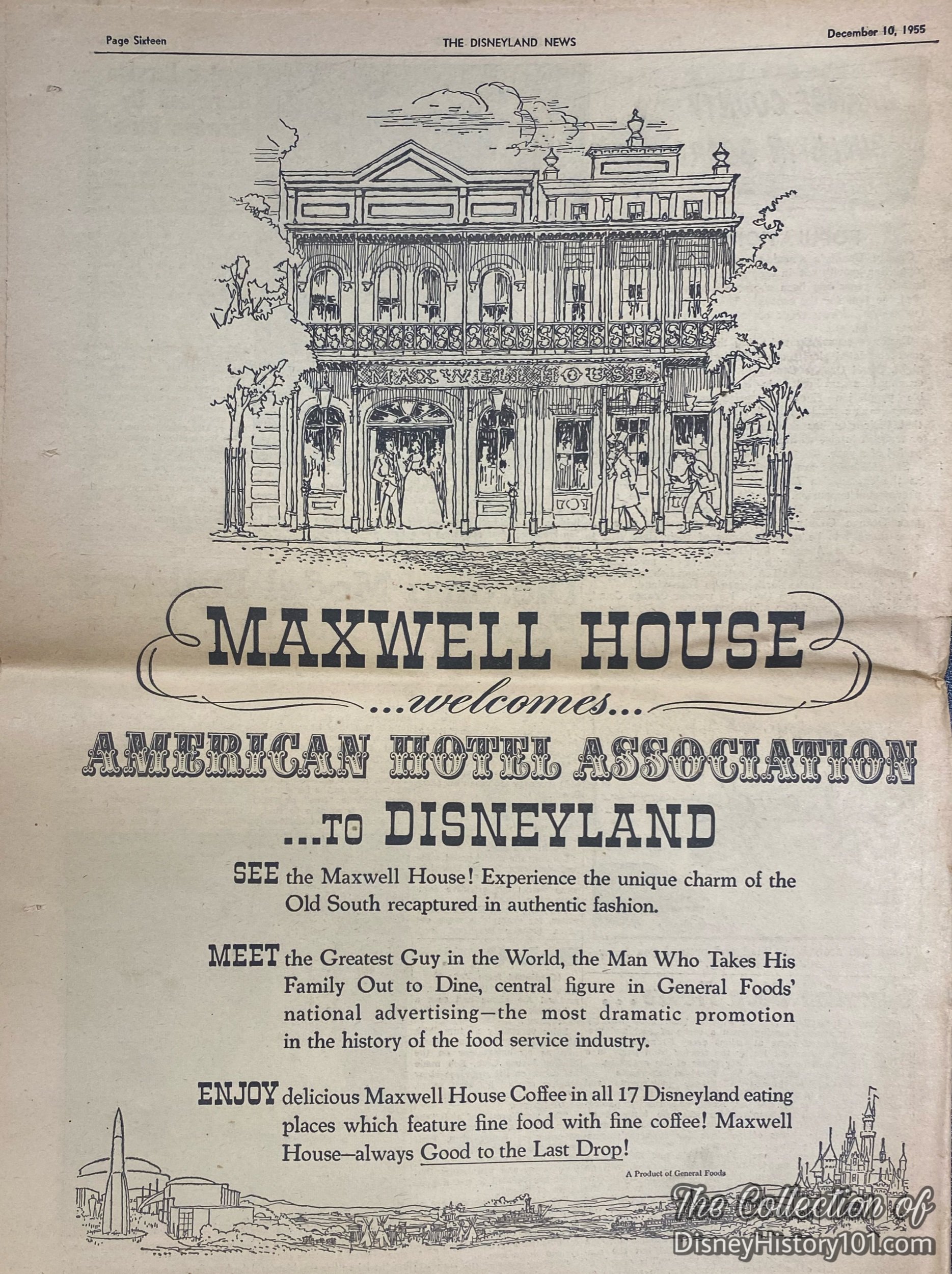
THE DISNEYLAND NEWS, December 10, 1955; Page Sixteen.
“The Greatest Guy In The World - The Man Who Takes His Family Out To Dine”
We are (of course) referring to another individual (in addition to Walt), who was key to the placement of the Disneyland lessee. The Maxwell Coffee House (as other restaurants and concessions) was strategically placed by Mister James D’Arcy. Owning to this, Ron D’Arcy would become part of the opening Maxwell House crew. Long before New Orleans Square, the decor of the Maxwell House represented “the New Orleans section of the ‘Old South’. Built to resemble a hotel of that time and place, it offers a jewel-like lobby sumptuously decorated with crystal chandeliers and velvet and plush furnishings. Past the lobby is the intimate coffee shop, serving coffee and pastries. Although indoors the coffee shop ceiling fades away to a midnight blue and stars twinkle above.” If some of the “railing and cresting (found here and other places on Main Street U.S.A. and Frontierland)” look authentic, its because some of them actually “came from old plantations in Nashville, Memphis, Tennessee, and some came from San Francisco, Oakland and Sacramento, California, dating back to the ‘49 days,” according to “News From Disneyland” (a Press Release document published c. 1956).
Maxwell Coffee House at Disneyland offered guests a variety of Maxwell House beverages including delicious Maxwell House Coffee, refreshing Maxwell House Iced Coffee, steaming Maxwell House Tea, refreshing Maxwell House Iced Tea, Baker’s rich Hot Cocoa, and Baker’s Ice Cold Chocolate Flavored Drink. Though the restaurant did not serve meals, it did carry a variety of light snacks (or, “Specialty items”) including Apple Sauce Cake, Homemade Danish pastry (served warm), Superb Cheese Cake (which paired well with a cup of Maxwell House Coffee), Old Fashioned Strawberry Short Cake, Assorted French Pastries, Hot Fudge Ice Cream Cake, and a fancy Jell-O gelatin dessert topped with whipped cream!
On December 10, 1956, George Banning, distributor of Maxwell House coffee provided beverages for the First Annual Christmas Party.
Both Walt Disney and those who held his business ethics, principles, and standards for Disneyland, made sure that the price of coffee was always economical and reasonable. Walt assured that coffee was “only worth a dime.” This was true during Maxwell’s participation and during participation of the following sponsor. After Walt’s passing, “Card Walker, Vice President of advertising and sales, further insisted, ‘Disneyland will always have a ten-cent cup of coffee.’ It wasn’t until after Walt’s passing in 1966 that the price increased,” according to “Eat Like Walt - The Wonderful World of Disney Food” by Marcy Smothers.
The corporate synergy was good for a time. Institutional lessee Maxwell House Coffee yielded some revenue for Disneyland Inc. - $28,599 for the fiscal year ending September 29, 1957 and $79 for the remainder of its occupation during the fiscal year ending September 28, 1958. The synergy was also beneficial for both. For instance, when the Disneyland Recreational Club and Athletic Coordinator Frank Smith sponsored a new Gun Club, Maxwell House Coffee Shop hosted Disneylanders attending the first meeting on January 10, 1958.
Future additions to Maxwell were soon planned for Building 600, which would have included a large room and an office.
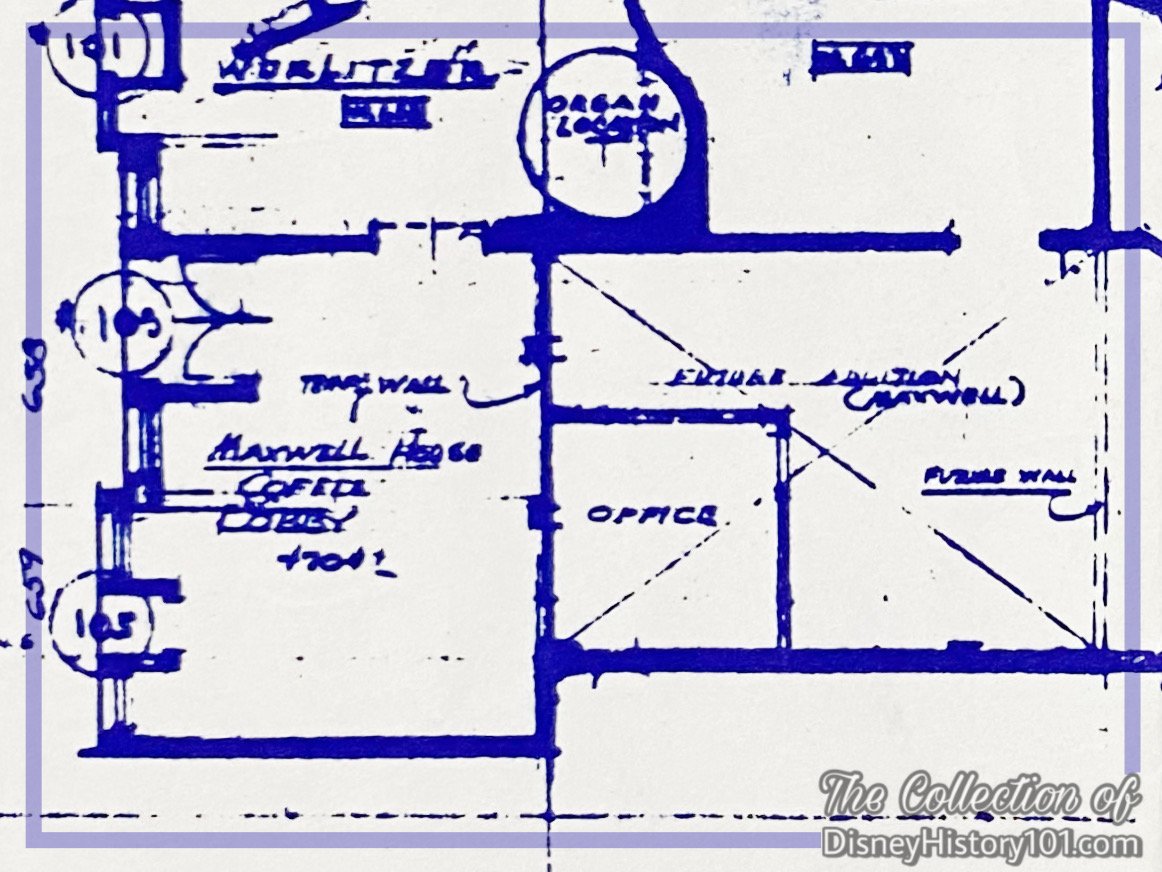
Note the Maxwell House Coffee Lobby, “Back of House” Office, and “Future Addition” in the Plan for 300 to 400 & 500 to 600, designed by WED Enterprises for Disneyland Inc., 1958.
However (by September 28, 1958), Disneyland Participant Affairs (or, “Industry Sales”) and Maxwell House could not negotiate a cooperative agreement to maintain their ongoing relationship. So Maxwell House would depart from Disneyland at a lease termination expense of $34,730.
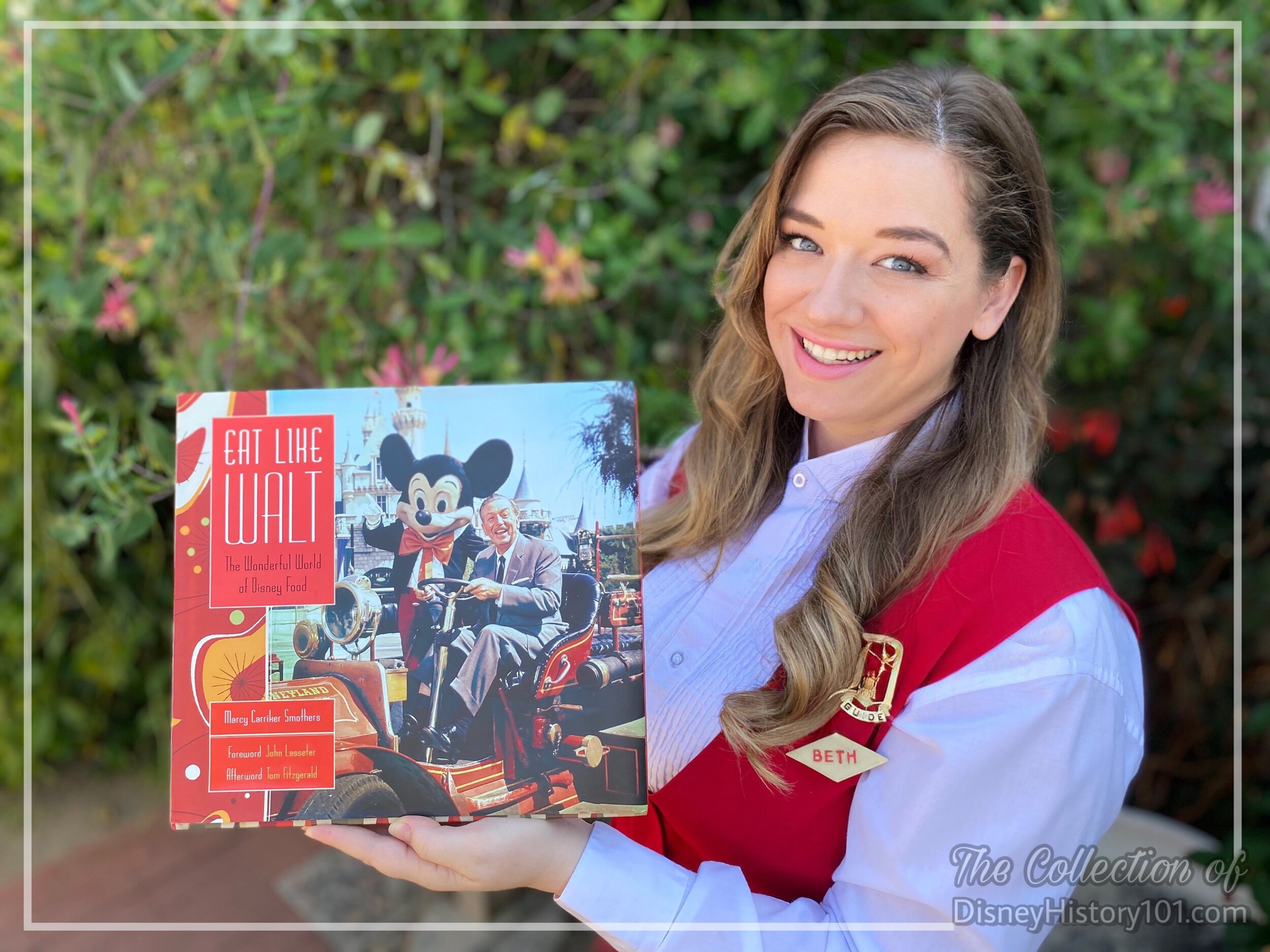
If you would like to read more about Maxwell Coffee House, it’s my pleasure to recommend adding Marcy Smothers’ “Eat Like Walt - The Wonderful World of Disney Food” to your personal Disney Home Library! If you would like to bring the magic of Disneyland restaurants and concessions to your dining room table, “please step this way” toward www.eatlikewalt.com where Marcy has shared a few recipes for memorable Disneyland menu options, including that of the Santa Fe Express Sundae, so that you too, can “Eat Like Walt!”

A number of Disneyland Participants sweetened the coffee of guests through the years! When Disneyland first opened in 1955, the “extra-fluffy and silky-soft” powdered sugar of Spreckels Sugar Company (of San Francisco, California) was the exclusive sugar of Disneyland. Creamy frostings were whipped up using Spreckels and guests dining at the Hills Bros. Coffee House would often sweeten their coffee with Spreckels sugar cubes and Spreckles sugar packets. Advertisements for Spreckels Sugar even ran in the earliest issues of “The Disneyland News.”

Spreckels Sugar Cubes
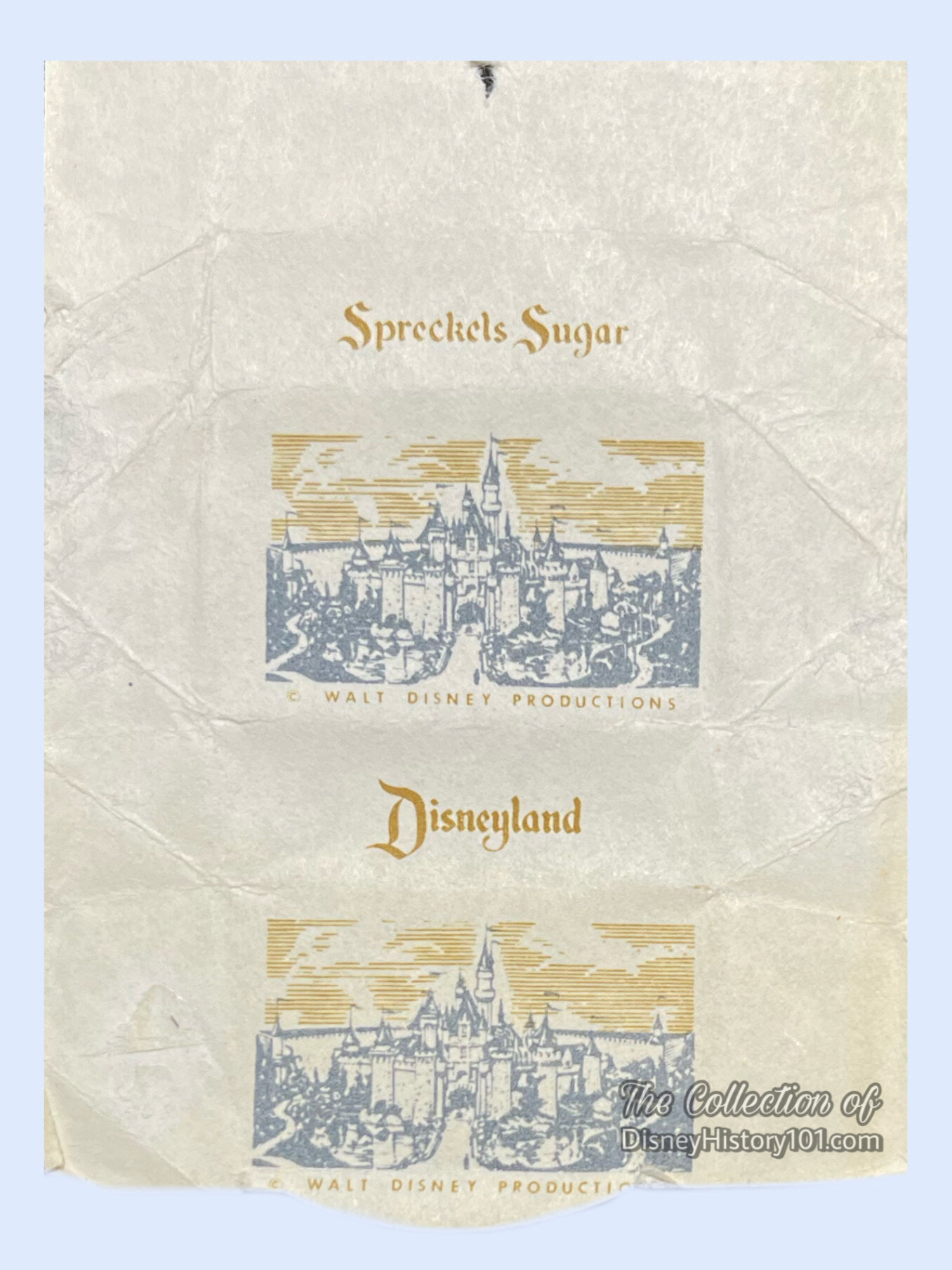
A Spreckels Sugar Cube wrapper.
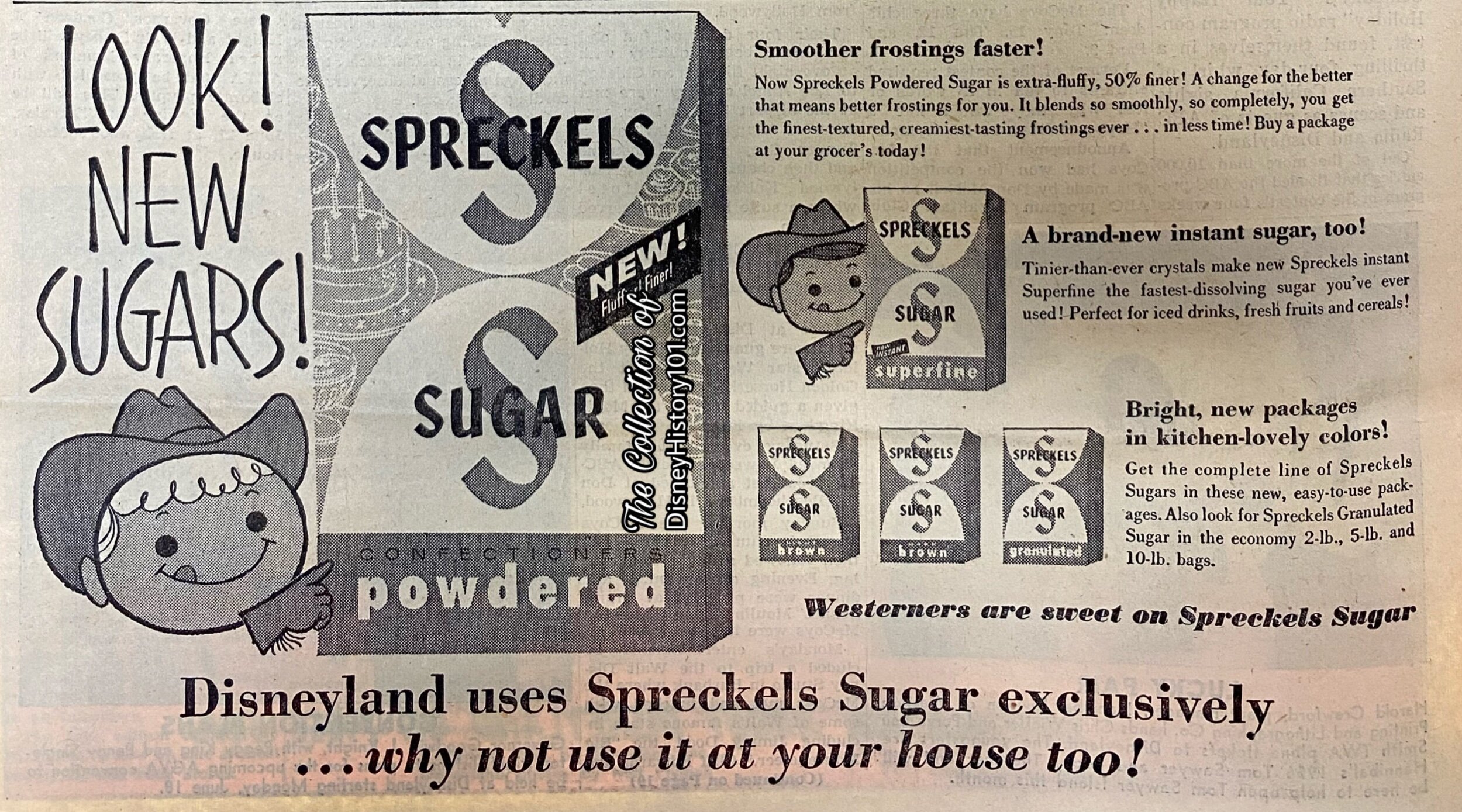
The Disneyland News Excerpt, June of 1956.
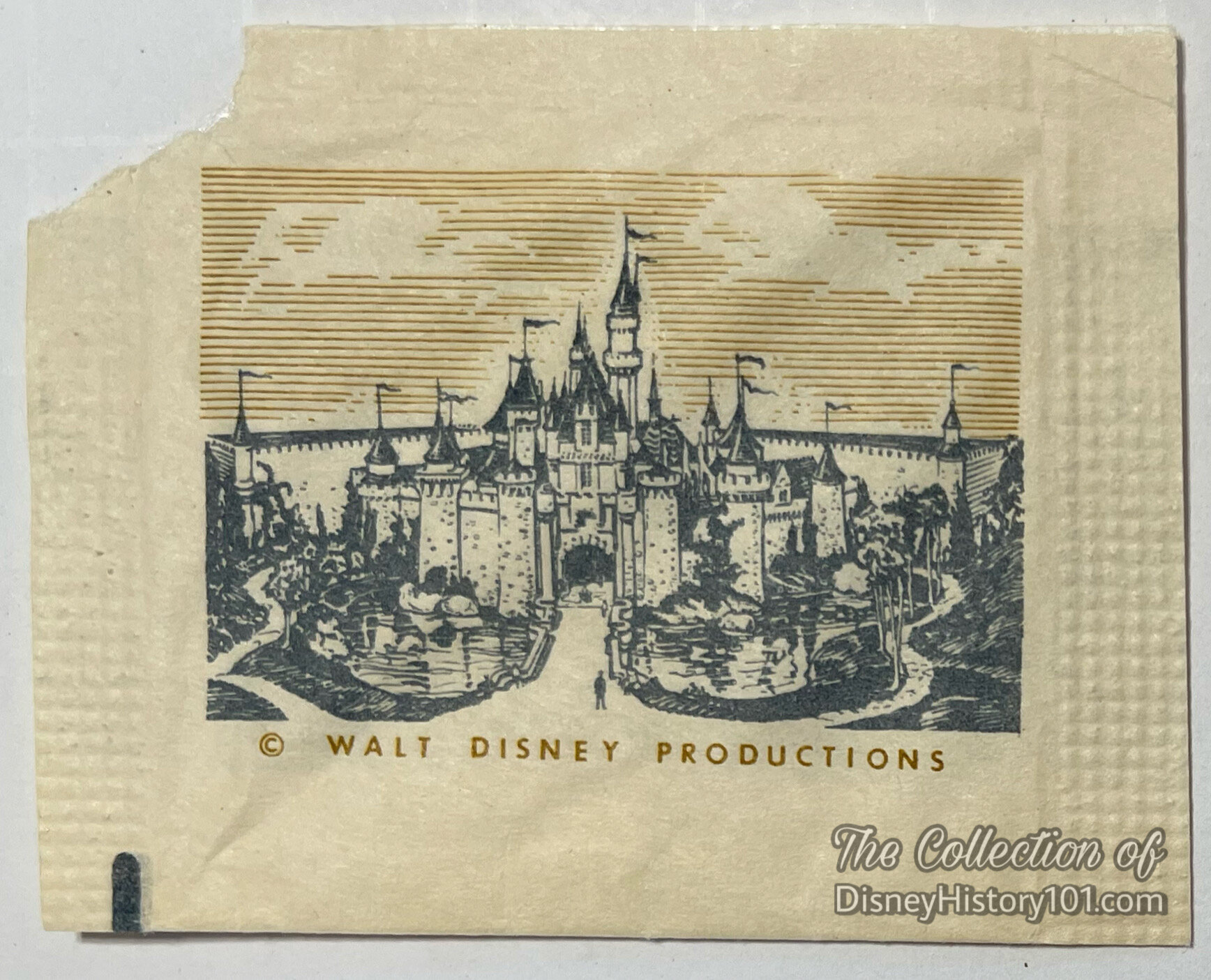
A Disneyland Spreckels Sugar Packet.
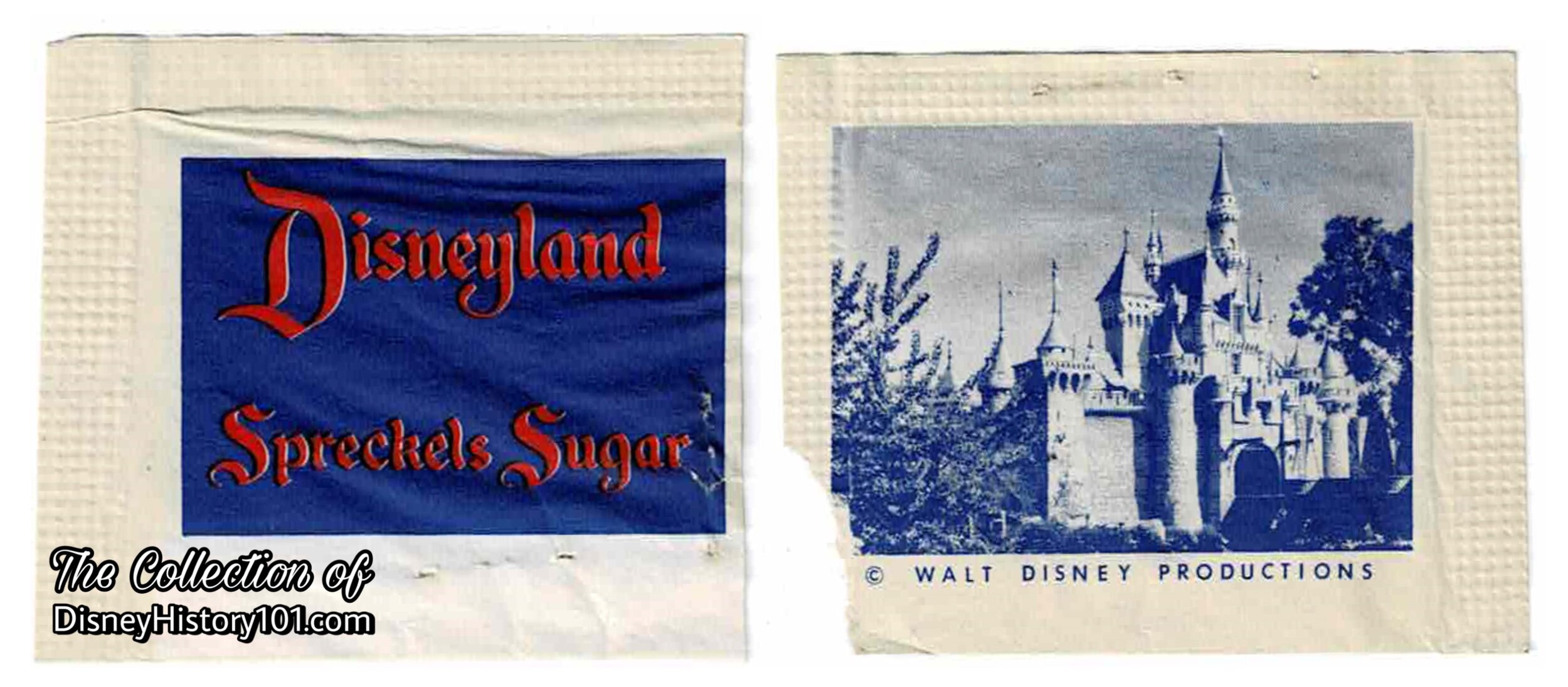
A Disneyland Spreckels Sugar Packet.
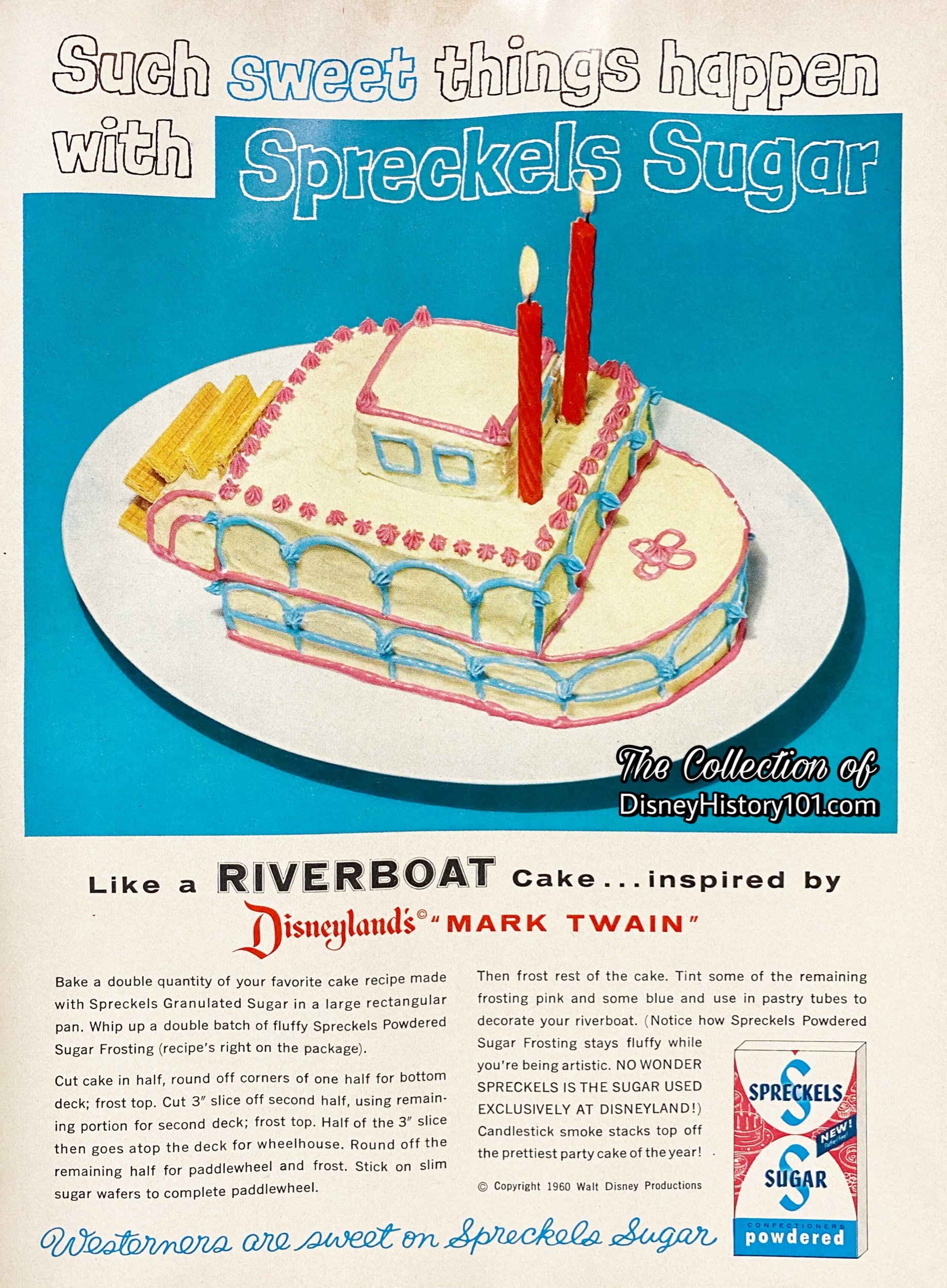
A cake inspired by the Mark Twain Riverboat was made with Spreckels Sugar.
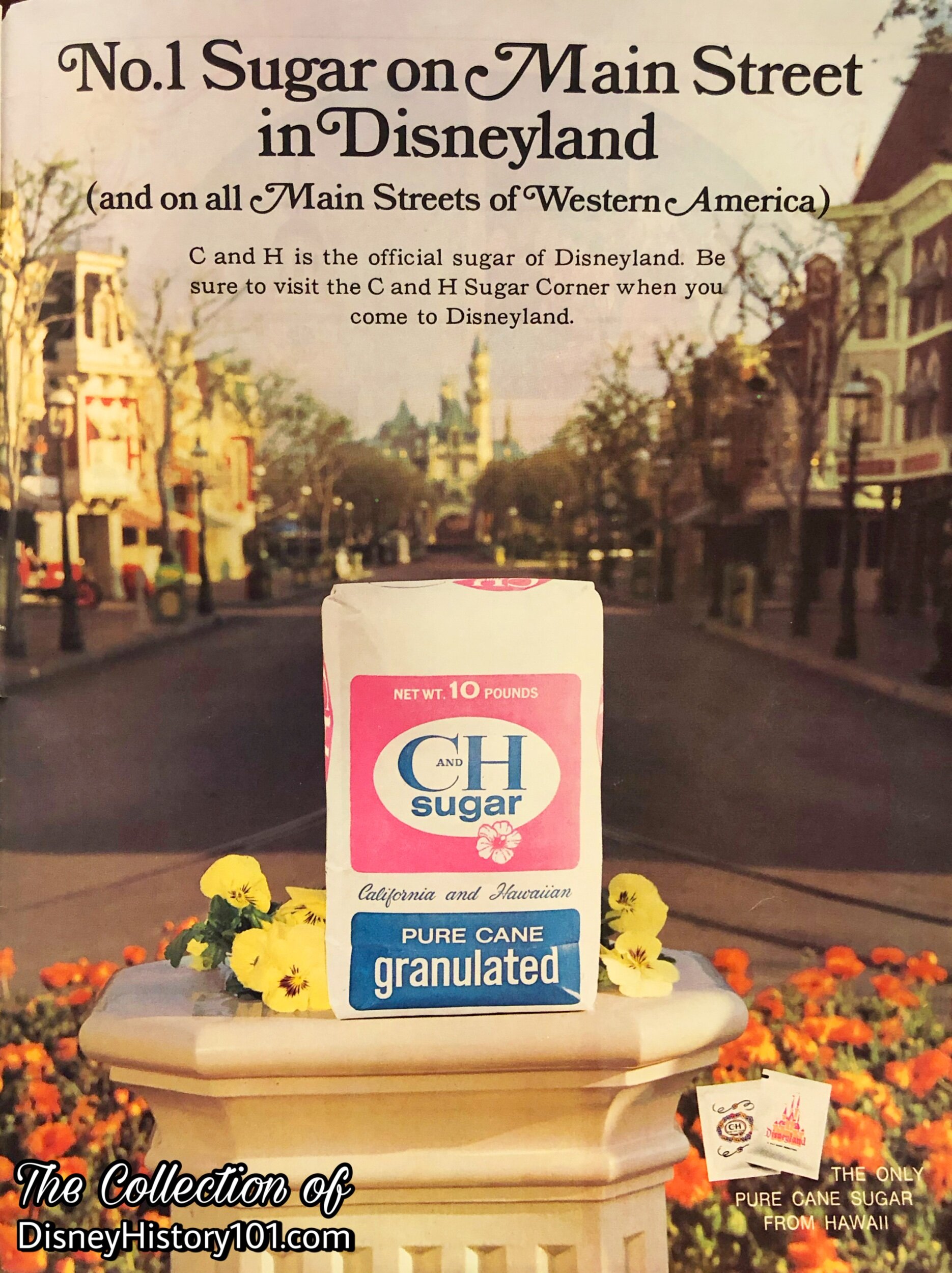
C&H Disneyland Advertisement
By 1972, Dixie Crystals became the official sugar of the Magic Kingdom and Walt Disney World. Soon, there was another “No. 1 Sugar on Main Street in Disneyland” - C and H Pure Cane Sugar from Hawaii. C&H became the official sugar of Walt Disney’s Magic Kingdom, in 1962! Still other sugar brands (like Domino Sugar) could be found contemporaneously at Wrather Corporation’s Disneyland Hotel.
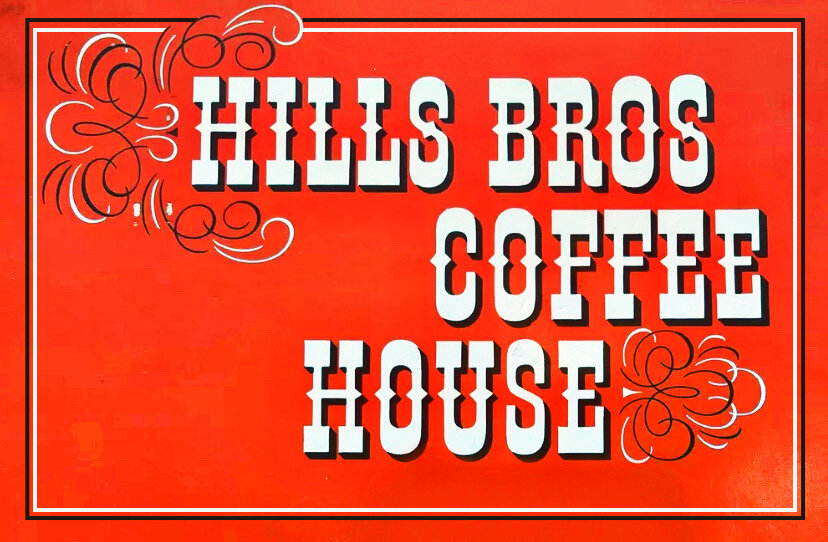
Hills Bros Coffee Garden (June 13, 1958 - December, 1976)
The corporate synergy was “good ‘til the last drop,” until (after less than two years) Participant sponsor Maxwell Coffee departed from Disneyland. After a brief period of vacancy (at least by January 1, 1958), Hills Bros. Coffee stepped in to sponsor the 1,340 square-foot space and additional 180 square-foot kitchen. The remaining Maxwell Coffee House interiors were sold to Hills Bros. at a cost of $27,500.
Only now (by 1958-1959), the leaseholder - Hills Bros. - made an improvement. Disneyland Inc. opened Hills Bros. Patio Job #032-50-26 for the construction of an addition to the Kitchen and dishwashing area of the building and an open patio adjoining Hills Bros. premises on the East side of building and facing Town Square.
Preliminary Designs were created by the Studio at the cost of $1,549.47, and working drawings were created (by the studio at $390.65; by another party at $438.88). Curtains, shades, awnings & canopy were fabricated at a cost of $301.27. Including the Studio EB (part before direct distribution), Studio overhead @ 25%, Studio charges, Construction Overhead, Subcontracts (in the IBM job file), total costs for Job #032-50-26 totaled $26,144.47. After a portion of the job was billed to Hills Bros., the cost was $4,255.00, with a $21,889.47 net to capital.
The additions of enlarging both the kitchen and dish-washing areas were later appraised at $4,000. An 8’x12’ women’s dressing room (Job #032-50-50; constructed at $1,248.02) was also attached to the Hills Brothers storeroom in the service area.
Before long, “a taste of San Francisco” arrived with the Hills Brothers Coffee Shop and Coffee Garden operated by Food Service, Inc. The interior of the restaurant was still decorated in a “southern garden motif with an adjacent dining patio,” according to the “Disneyland Dictionary” (compiled by WED Enterprises, Inc. and WED Public Relations Department, c. 1968).
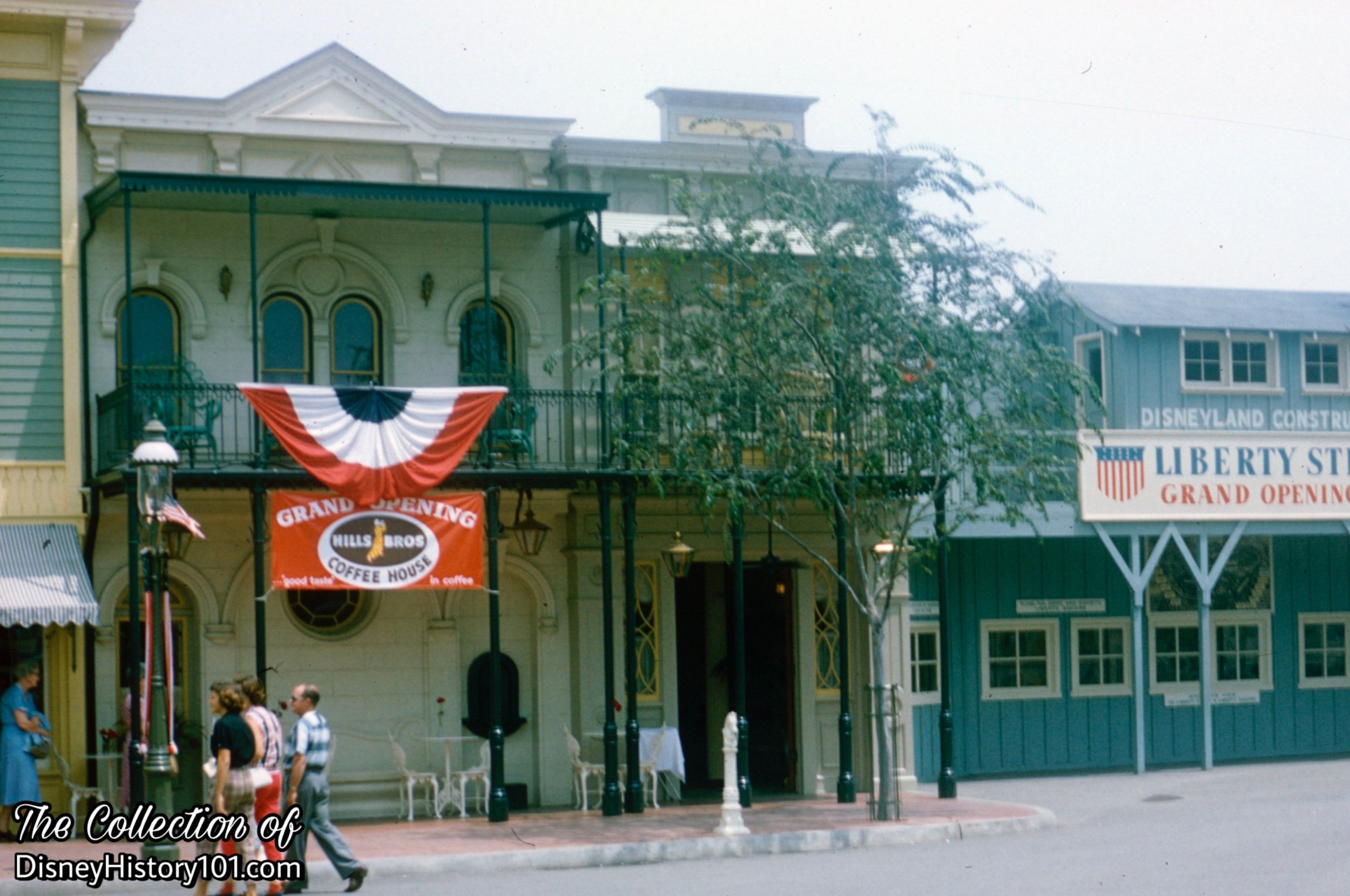
The Grand Opening of Hills Bros., 1958.
Guests were soon welcomed “to the garden of ‘Ahh!’” Hills Bros. remained the sponsor of the Hills Bros. Coffee Garden for almost twenty memorable years! During this time, the Hills Bros. Coffee Garden offered waitress service, with a maximum guest capacity of 125.

Better Homes and Gardens "Famous Foods from Famous Places" (published by Meredith Press, 1964) gave a glimpse of the "Coffee House."
After the Park closed, the staff would take over with brooms, mops and dustcloths. Special attention was given to marred walls, posts and furniture. Items with marks that didn’t wash off were replaced or repainted. Floors were waxed and buffed to preserve their beauty and protect them from the thousands of feet that scuffled over them each day.
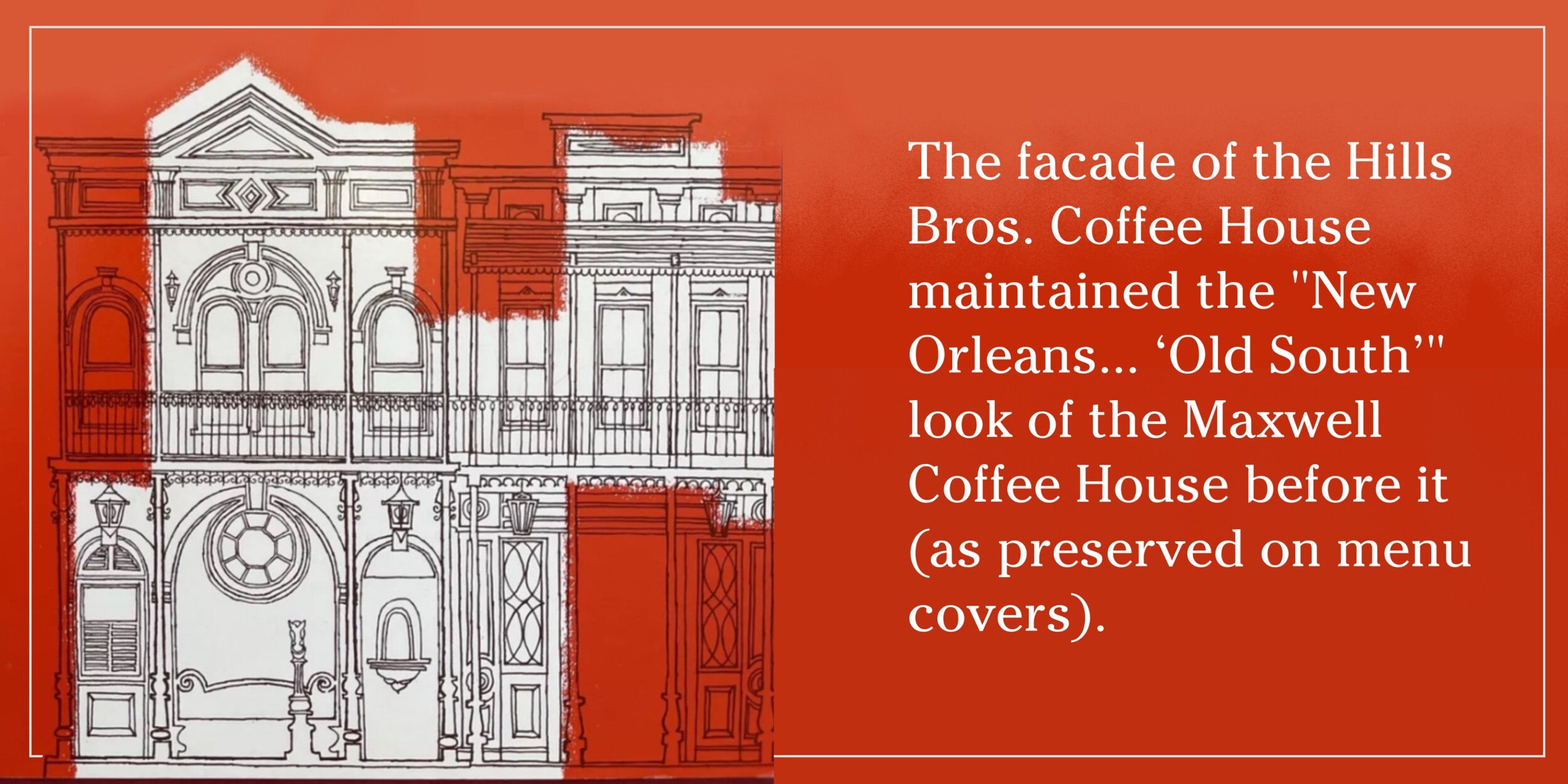

Hills Bros. Coffee Garden
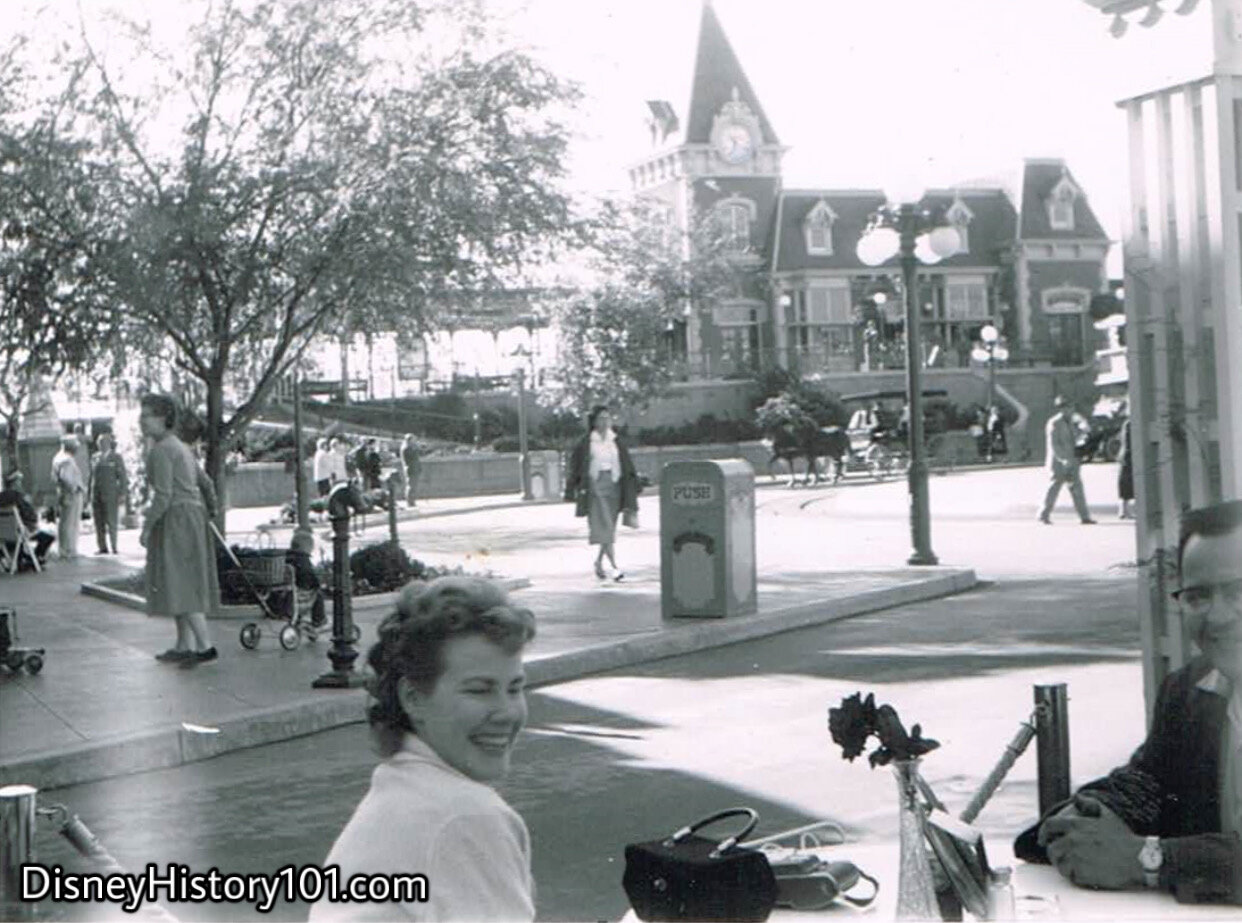
Hills Bros. Coffee House Patio, (1960)
These guests prefer to brighten their “morning with a cup of delicious Hills Bros. Coffee!” The Town Square tradition of enjoying a cup of coffee in the garden continues as guests were invited to start their morning with a refreshing cup of Hills Bros. Coffee.
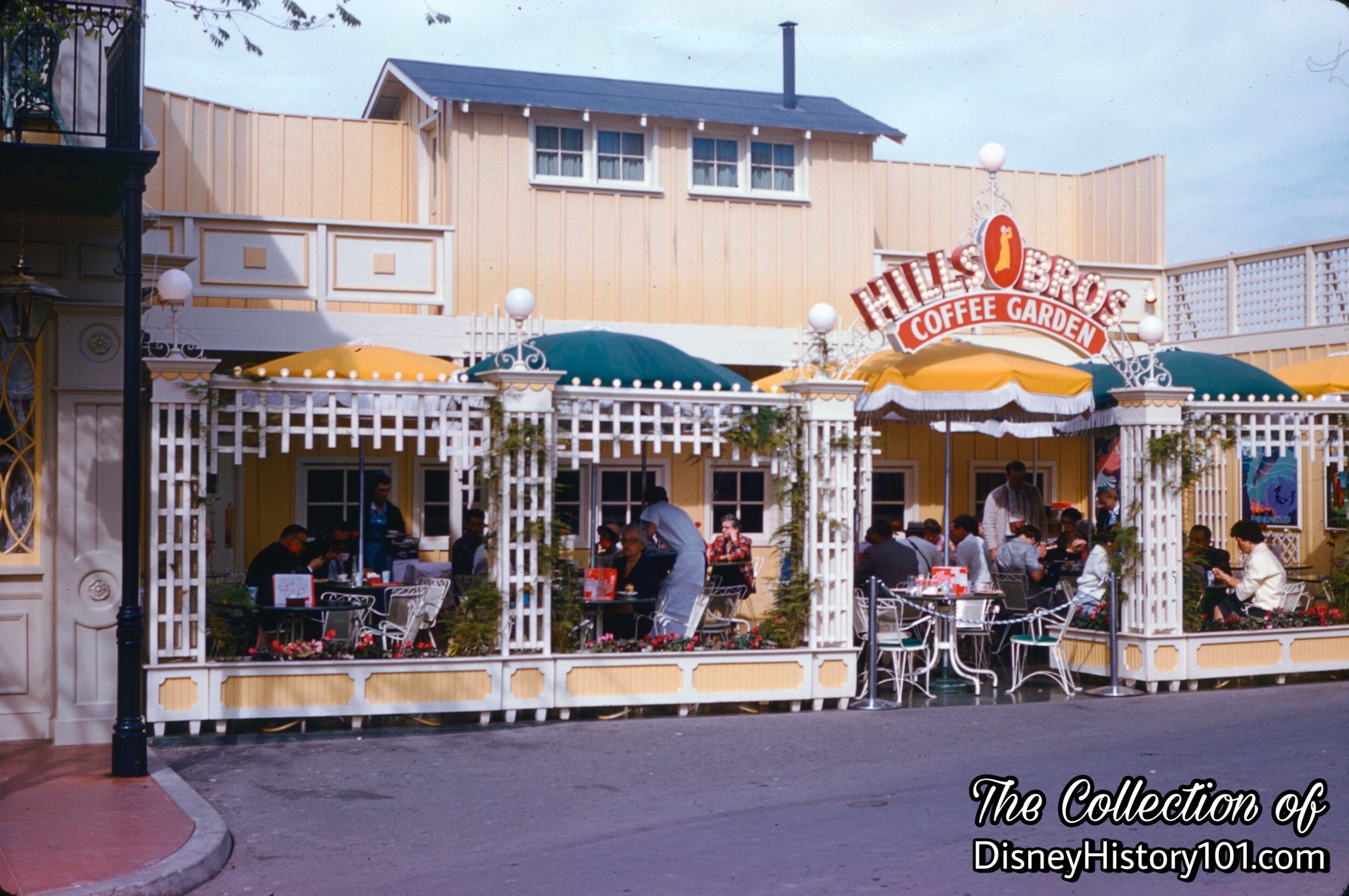
Hills Bros. Coffee Garden, (1961)

Disneyland visitors are welcome to relax with a Hills Bros. Coffee prepared either piping hot or icy cold. Youngsters can also recharge with nourishing drinks. Where the Maxwell Coffee House offered light snacks, Hills Bros. Coffee Garden offered meal items. According to one Disneyland Guide, guests could now “pause to enjoy freshly-made sandwiches and a variety of delectable desserts and beverages” at Hills Bros. Coffee Garden. Yes, in addition to beverages, doughnuts, breakfasts, and sandwiches were offered.
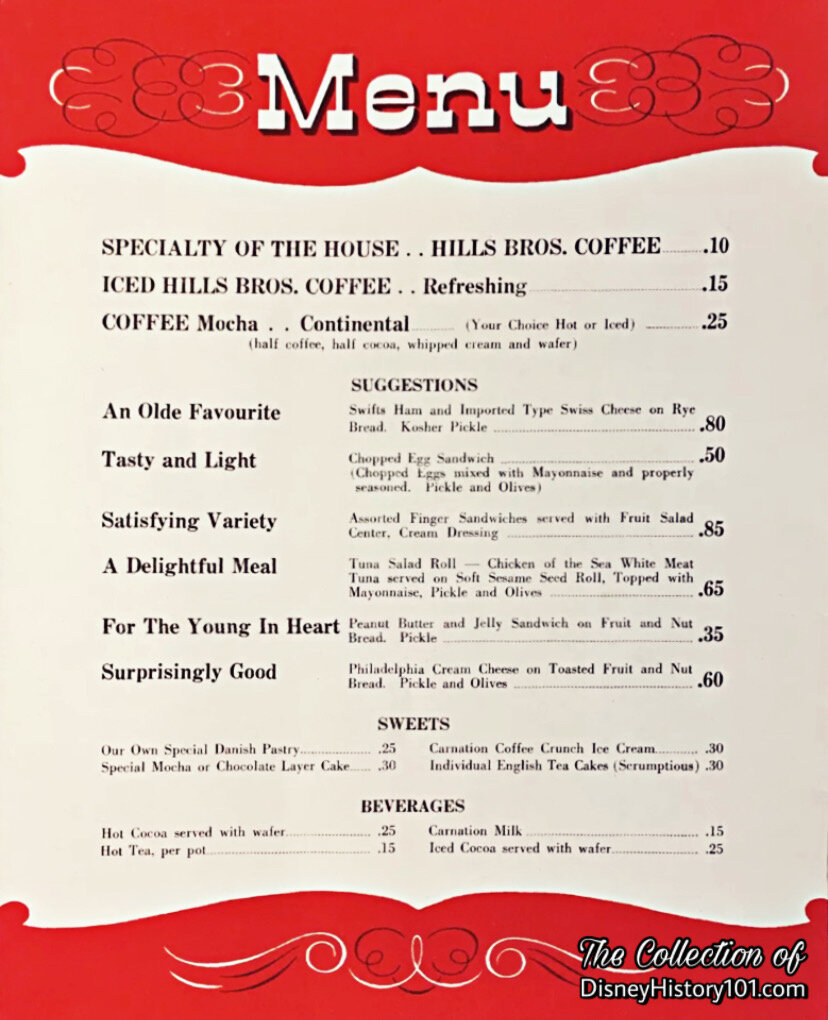
Hills Bros. Coffee House Menu, 1958.
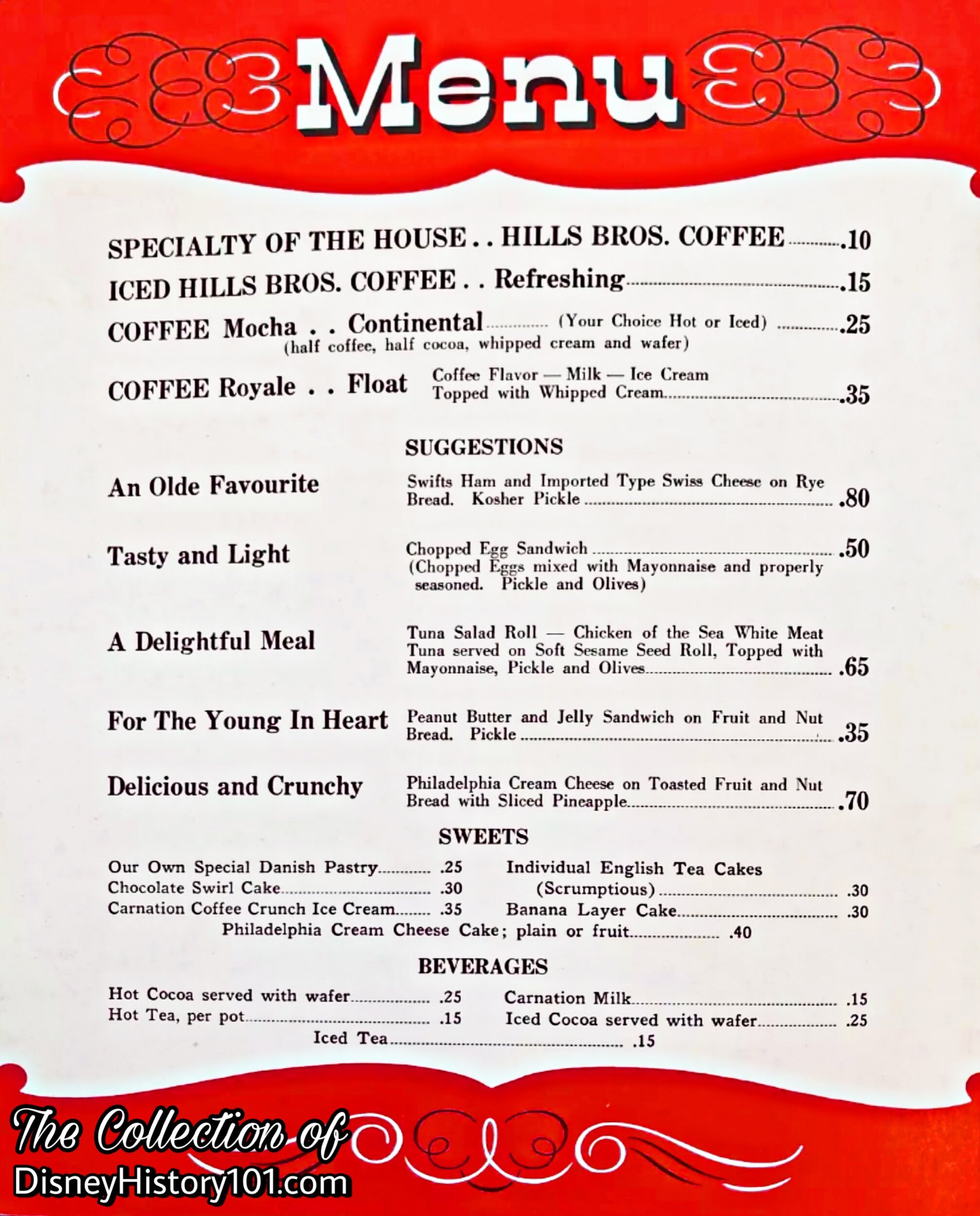
Hills Bros. Coffee House Menu with the addition of “Iced Tea,” Early 1960s
The option described as the “Delicious and Crunchy” suggestion was (on other menus) also referred to as the “Surprisingly Good” sandwich! But this sandwich was in like most - toasted fruit on a nut bread, with a Philadelphia Cream Cheese spread.
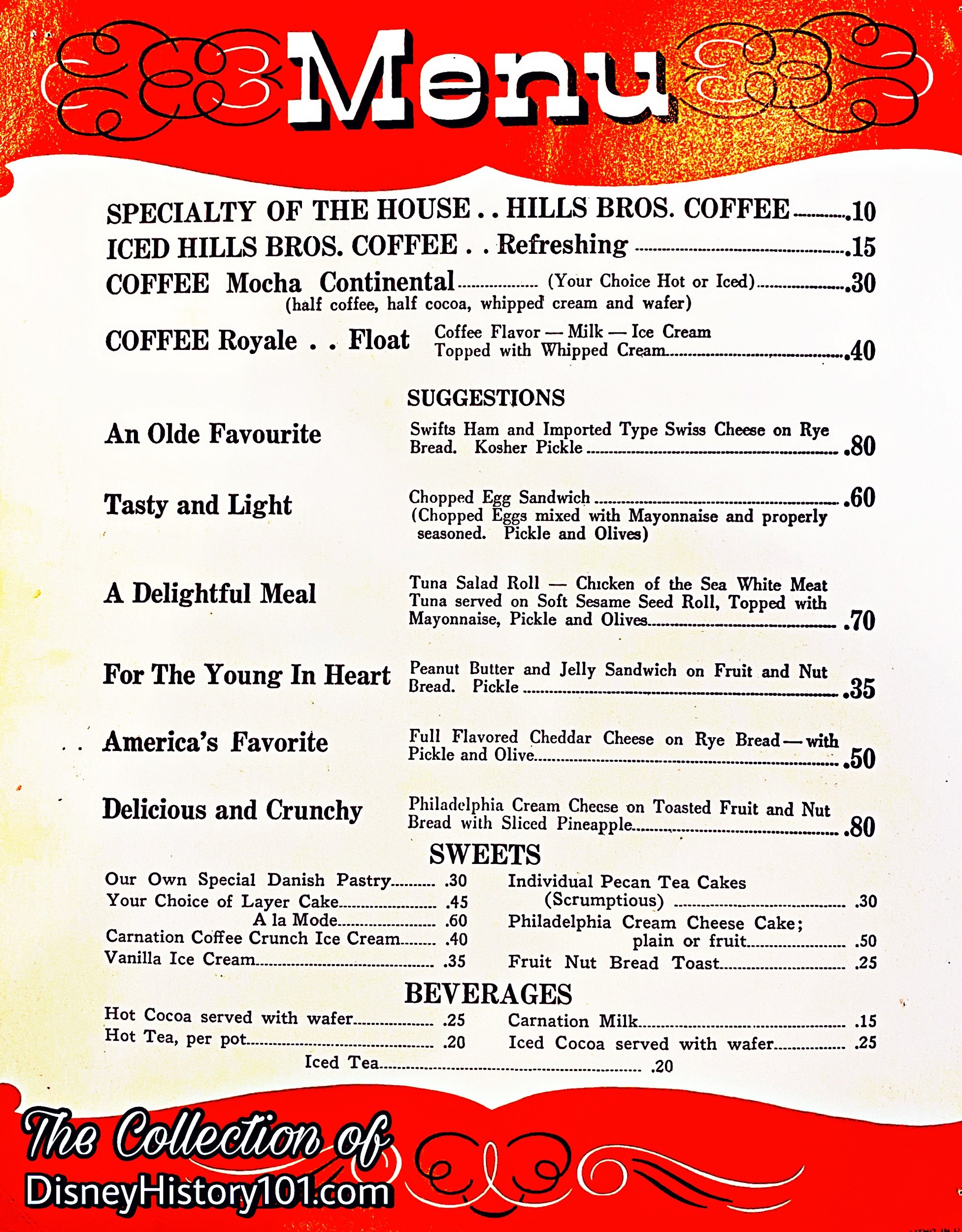
Hills Bros. Coffee House Menu, (1959-1960)
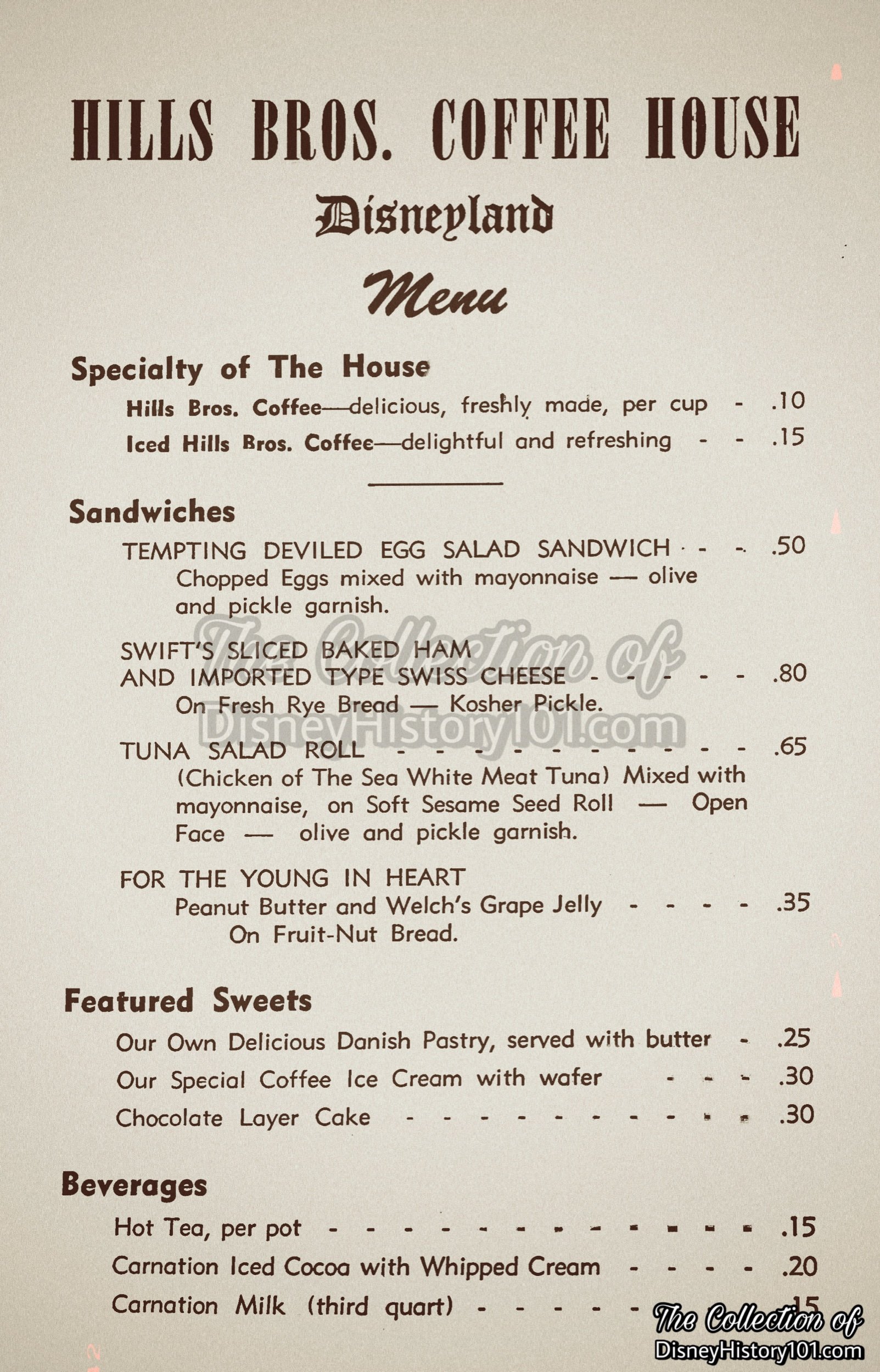
If all these delicious options weren’t enough, guests could also schedule direct reservations for dining at the Disneyland Hotel Gourmet Restaurant and Coffee Shop from the Hills Bros. Coffee House.
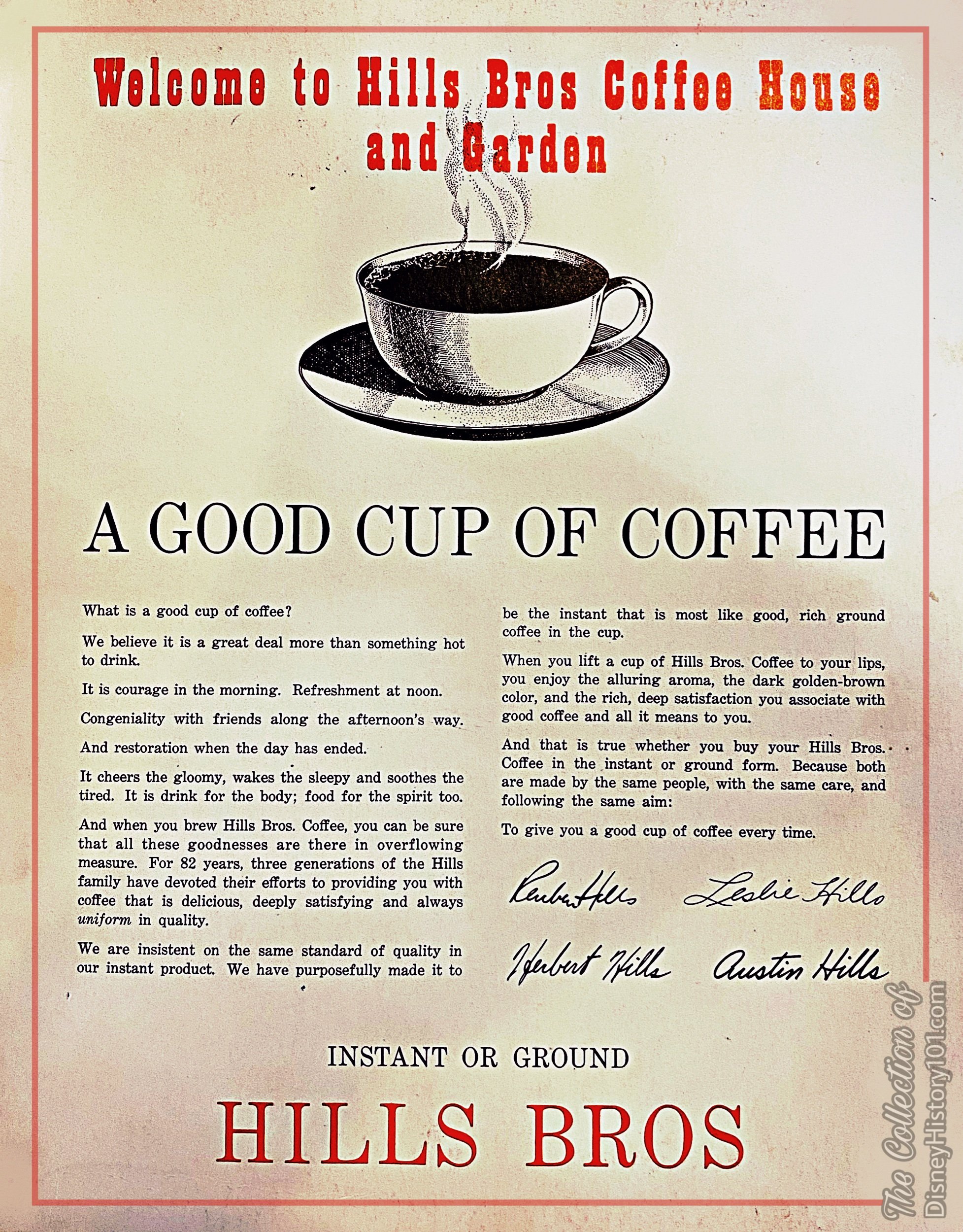
Hills Bros. Coffee House Menu Excerpt, (1959-1960)
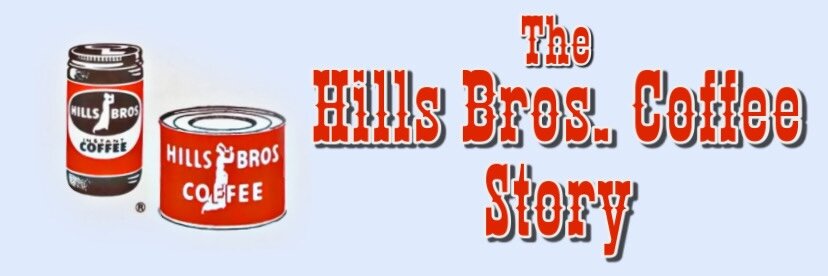
While relaxing with a cup of Hills Bros. Coffee, guests could pick up a menu and read the success story of Austin H. and Rubin W. Hill, as well as their innovations - “Instant Coffee” and vacuum-packaged coffee beans!
The corporate synergy was good for a time. Institutional lessee Hills Bros. Coffee, Inc. yielded some revenue for Disneyland Inc. - $9,626 for the fiscal year ending September 28, 1958.
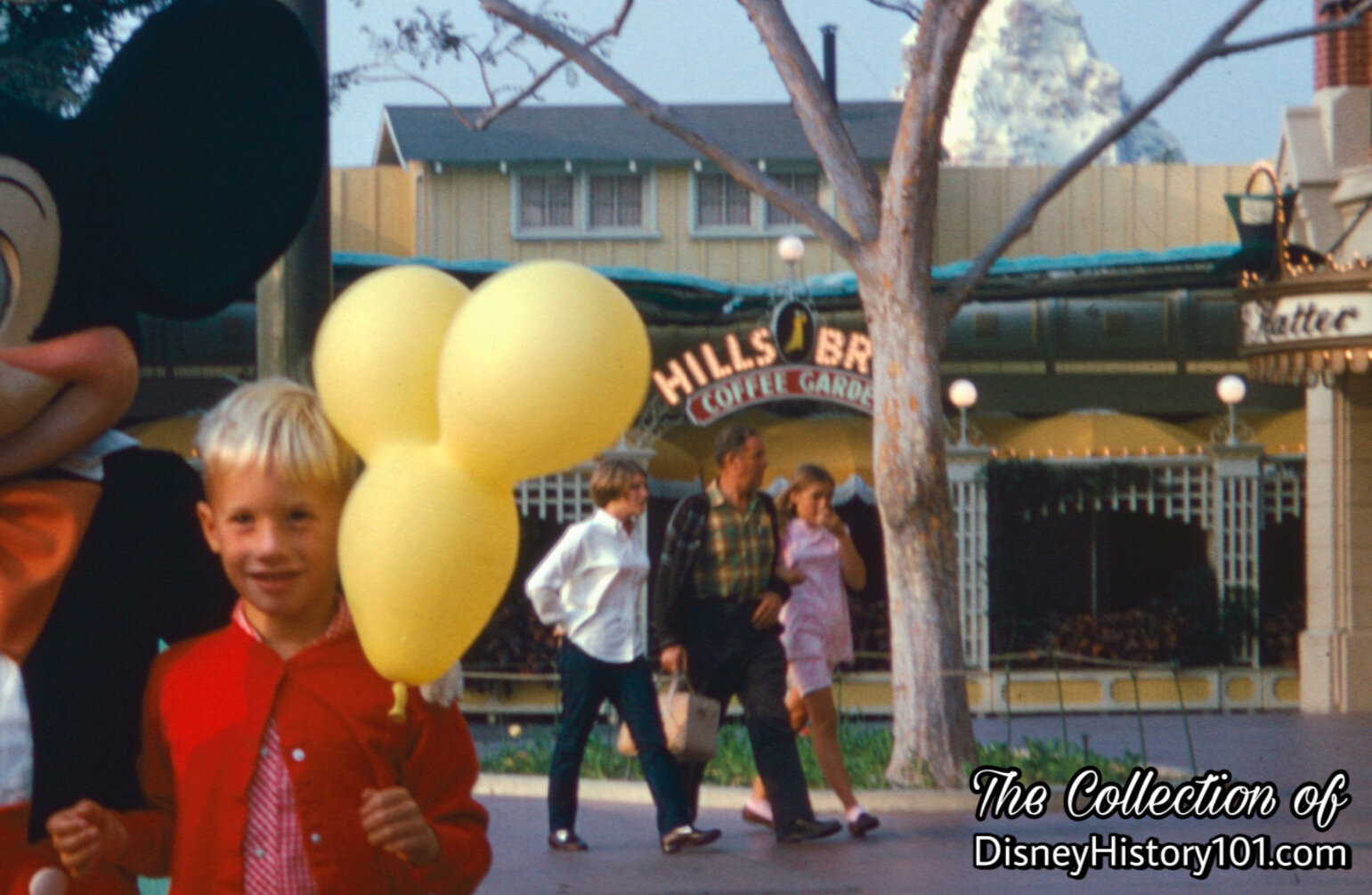
Hills Bros. Coffee Garden
Not far from where Mickey Mouse greeted guests, the Disneyland Christmas Carolers (under the direction of Dr. Charles C. Hirt and lead by Mr. Robert G. Hasty), also known to perform near “Hills Bros.” during various times of the day, from December 16th, 1967 thru January 1st, 1968. [“Disneyland Holiday Talent Master Schedule,” prepared for the period of December 16, 1967 through January 1, 1968]
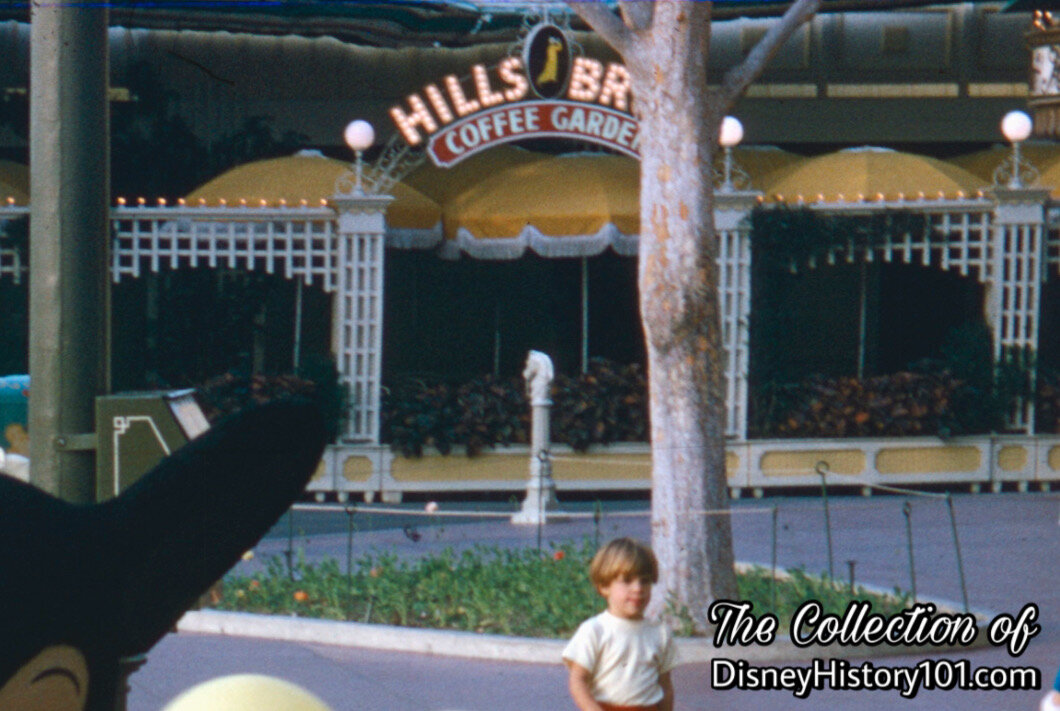
Hills Bros. Coffee Garden
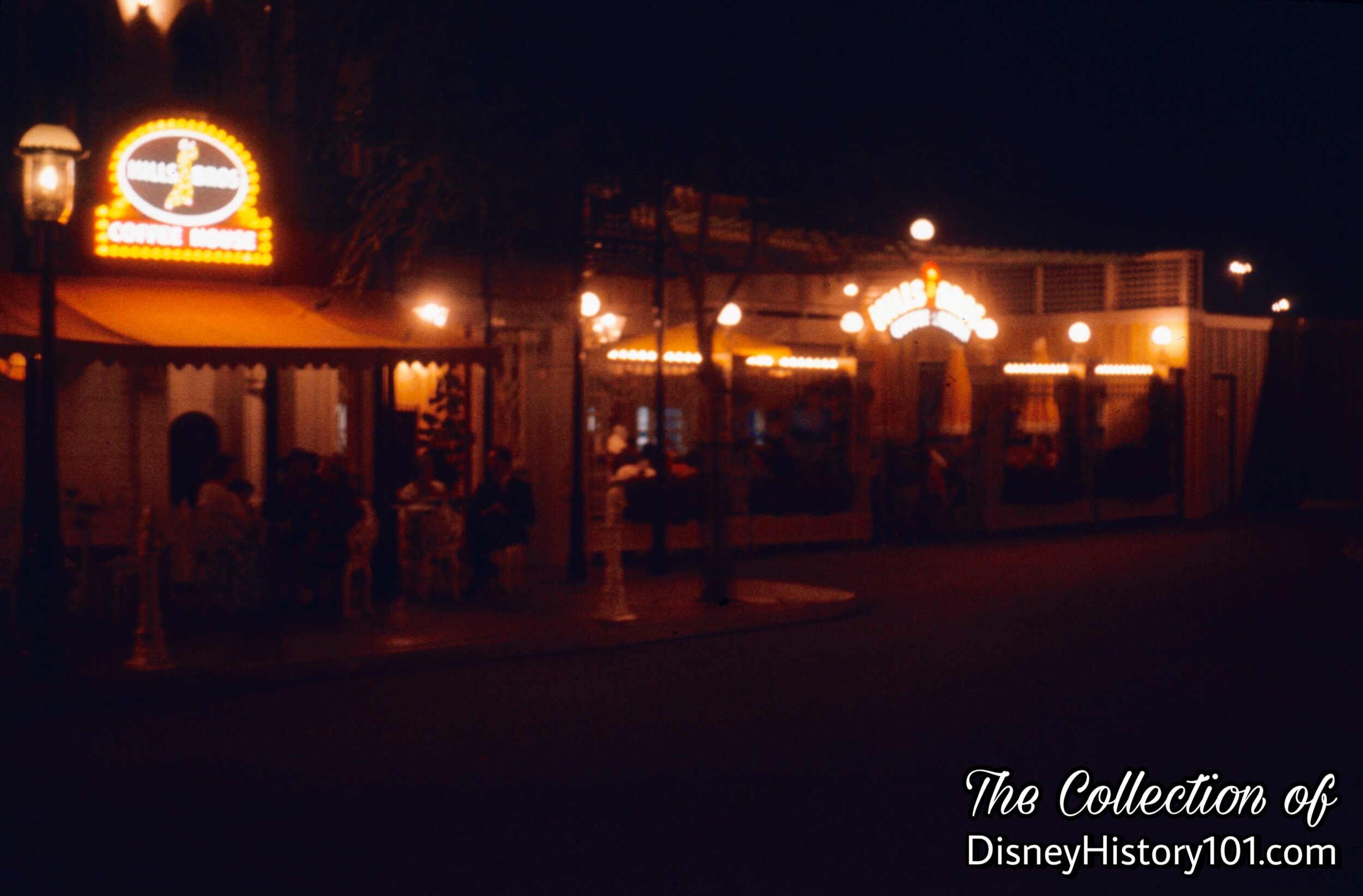
Hills Bros. Coffee House at Night
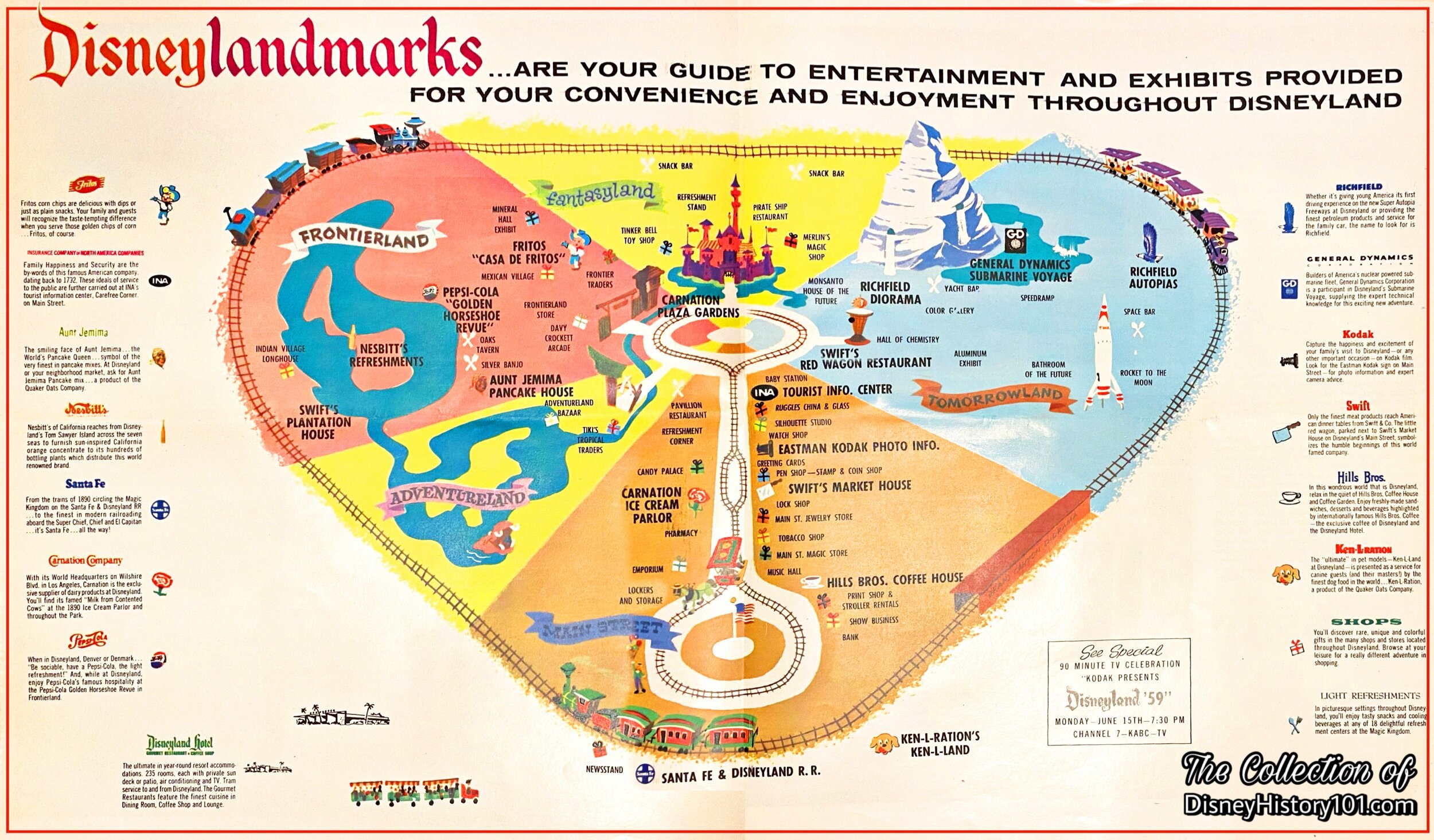
The first Disneyland Dictionary (printed in October of 1959) noted “Hills Brothers Coffee Shop and Coffee Garden operated by Food Service, Inc.” served “Hills Brothers' Coffee and light refreshments.” Owning to Jack Sayers (of Lessee Relations), Hills Bros. Coffee was a proud and contributing sponsor of “Disneyland ‘59”! In fact by October of 1959, Hills Bros. was (1) of over sixty-eight other firms playing a vital part in the team effort to bring happiness to Disneyland’s Guests. Some were small, specialized individual operators; some were huge companies such as Swift & Co. - the Bank of America - United Paramount Theaters (which you hear as UPT) - Carnation - Richfield - General Dynamics - Crane - and many others. These companies used the park to publicize their wares, leased space in the Park to sell their wares, and Disneyland collected advertising fees from them.
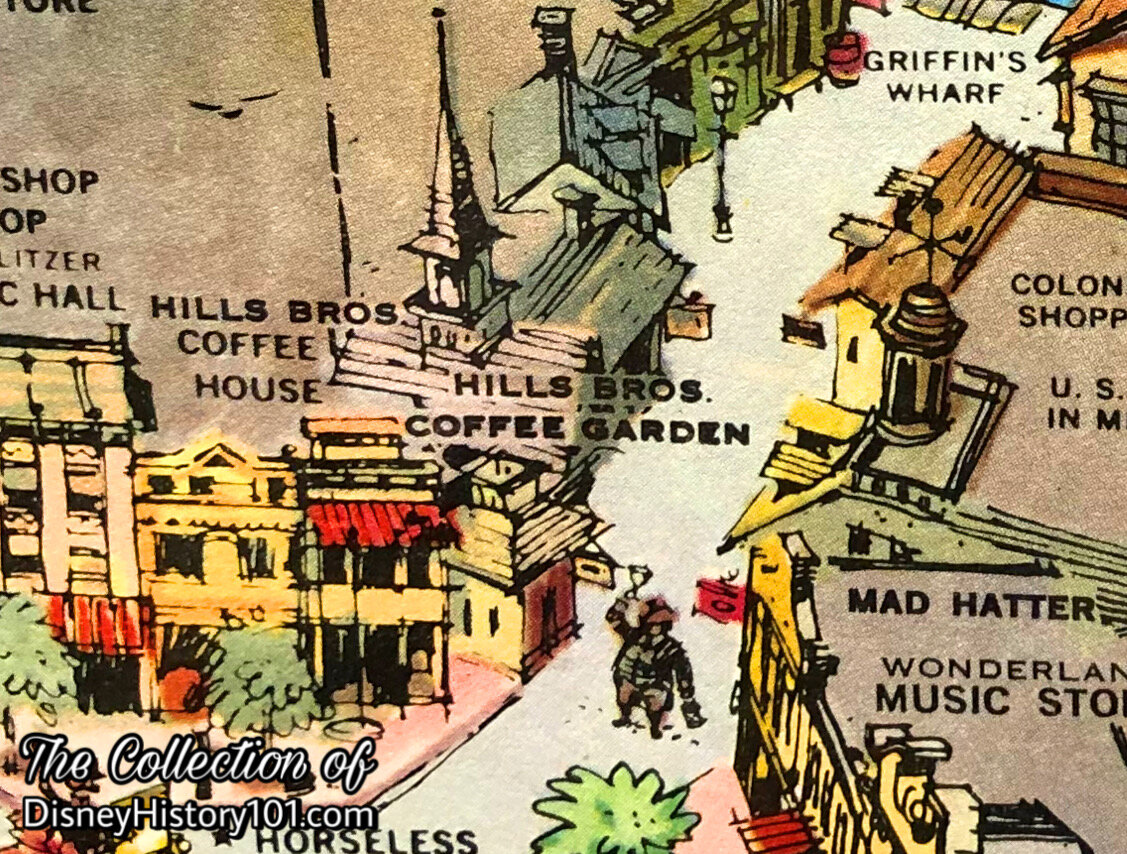
Disneyland Map Excerpt, c. 1960s
The Hills Bros. Coffee House would have stood at the gateway to the planned “Future Attraction” of Liberty Square.
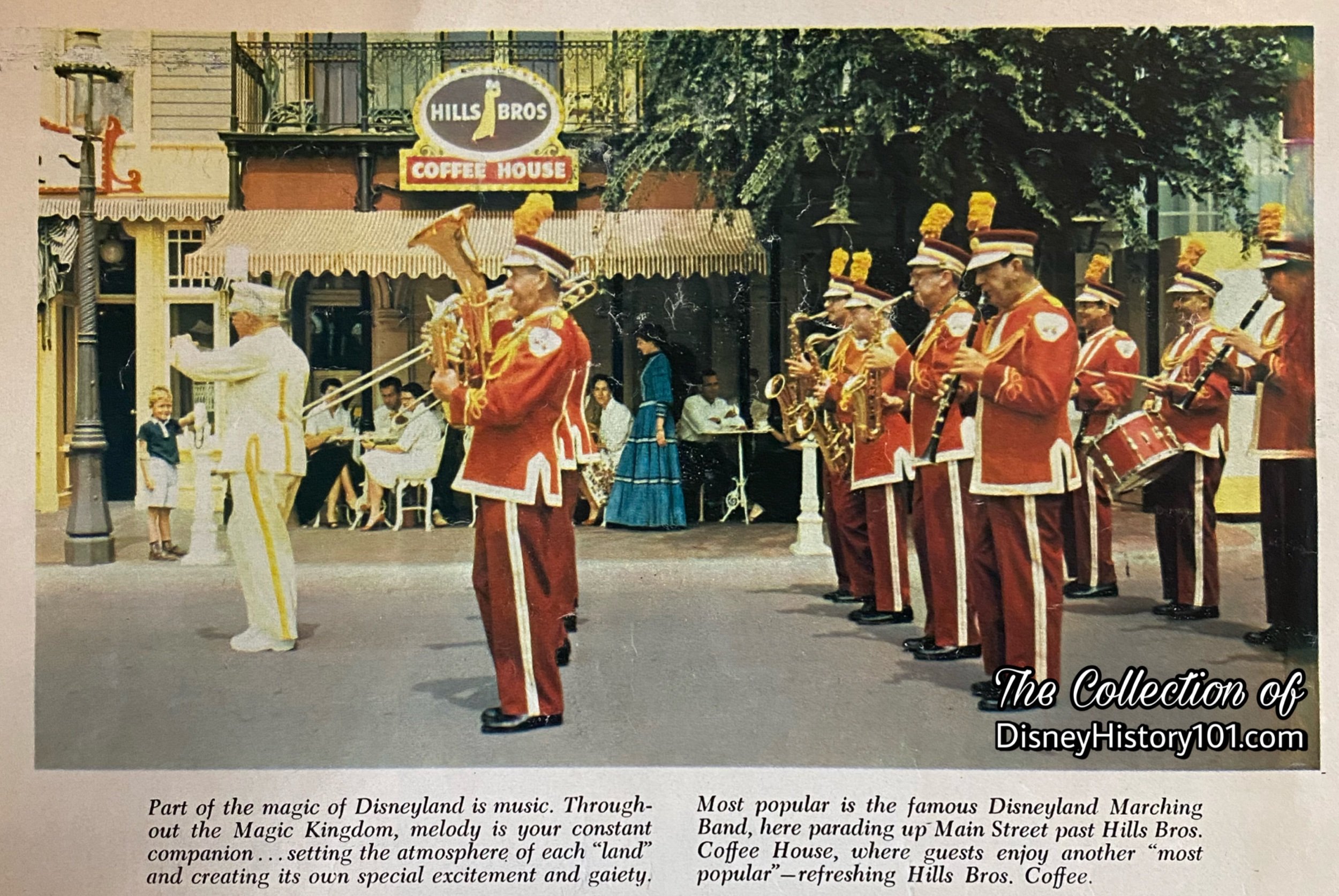
The Disneyland Band marches past Hills Bros. as seen in “Disneyland Summer ‘59” Supplement Excerpt.
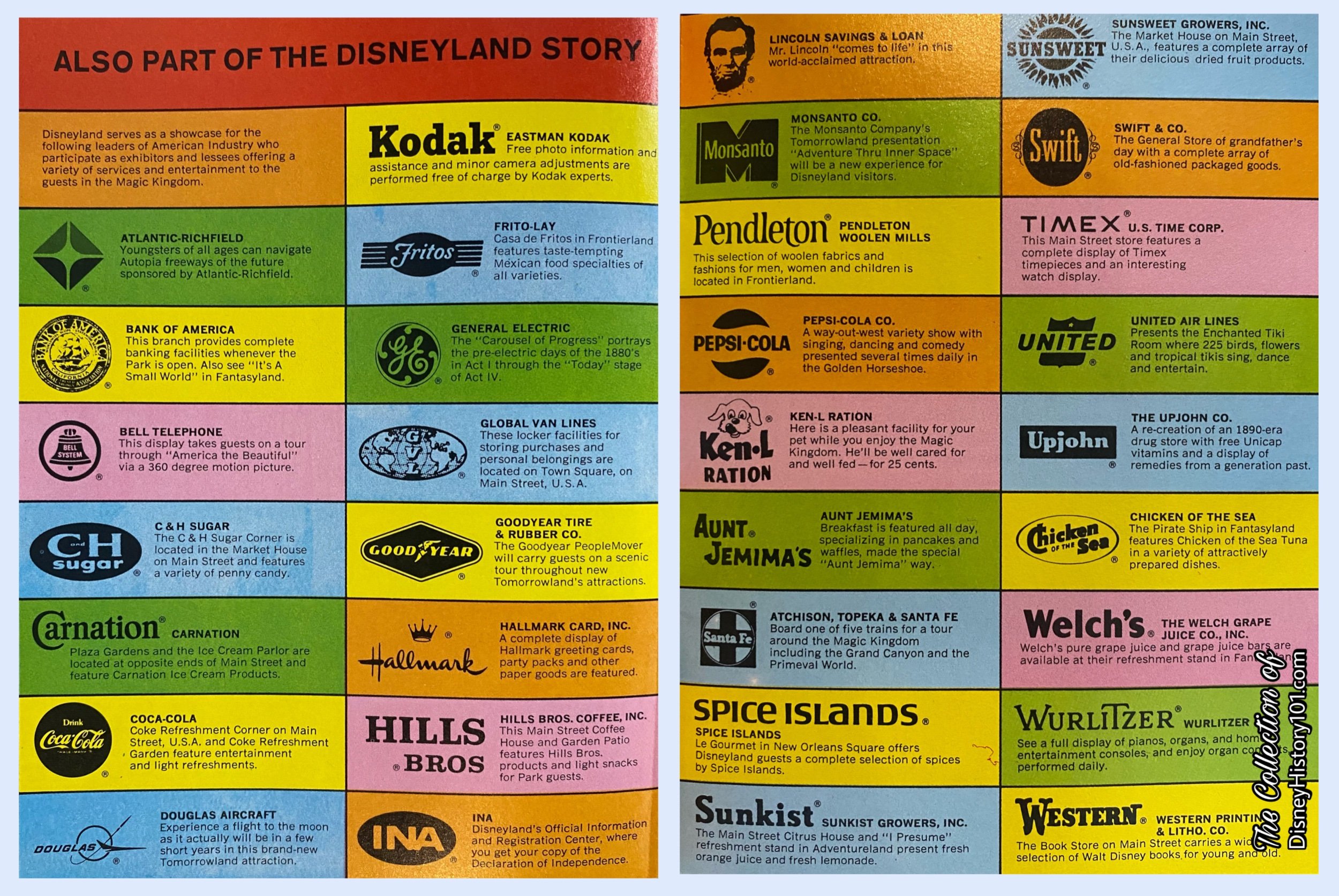
Hills Bros. Coffee, Inc. was a Disneyland Participant and thus “part of the Disneyland story according to this “Disneyland ‘67” Excerpt.
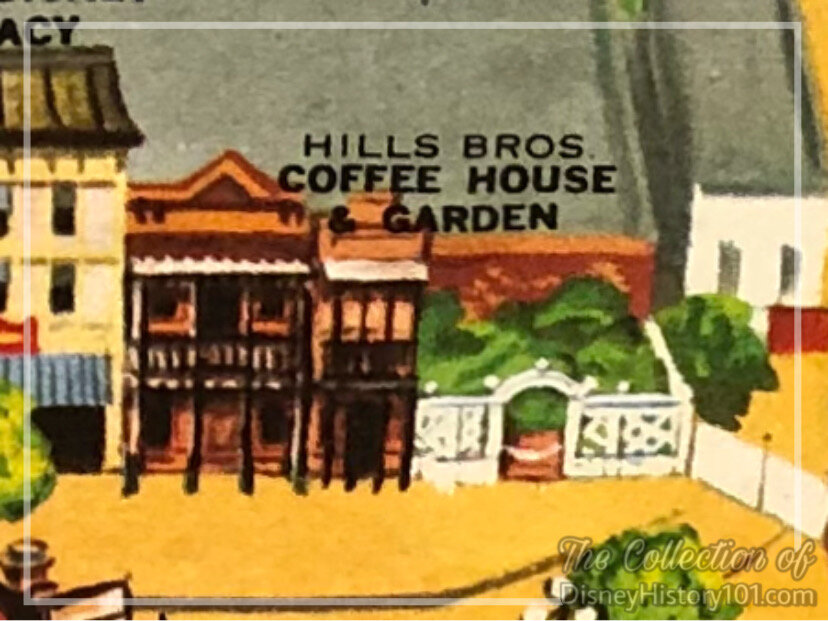
“Walt Disney’s Guide to Disneyland” Map Excerpt, c. 1968 - 1972
Sponsored by Hills Bros. Coffee Co., Hills Brothers Coffee House and Restaurant featured famous Hills Bros. coffee. The restaurant also offered tempting sandwiches and desserts within an interior that was in a southern garden motif with an adjacent dining patio.
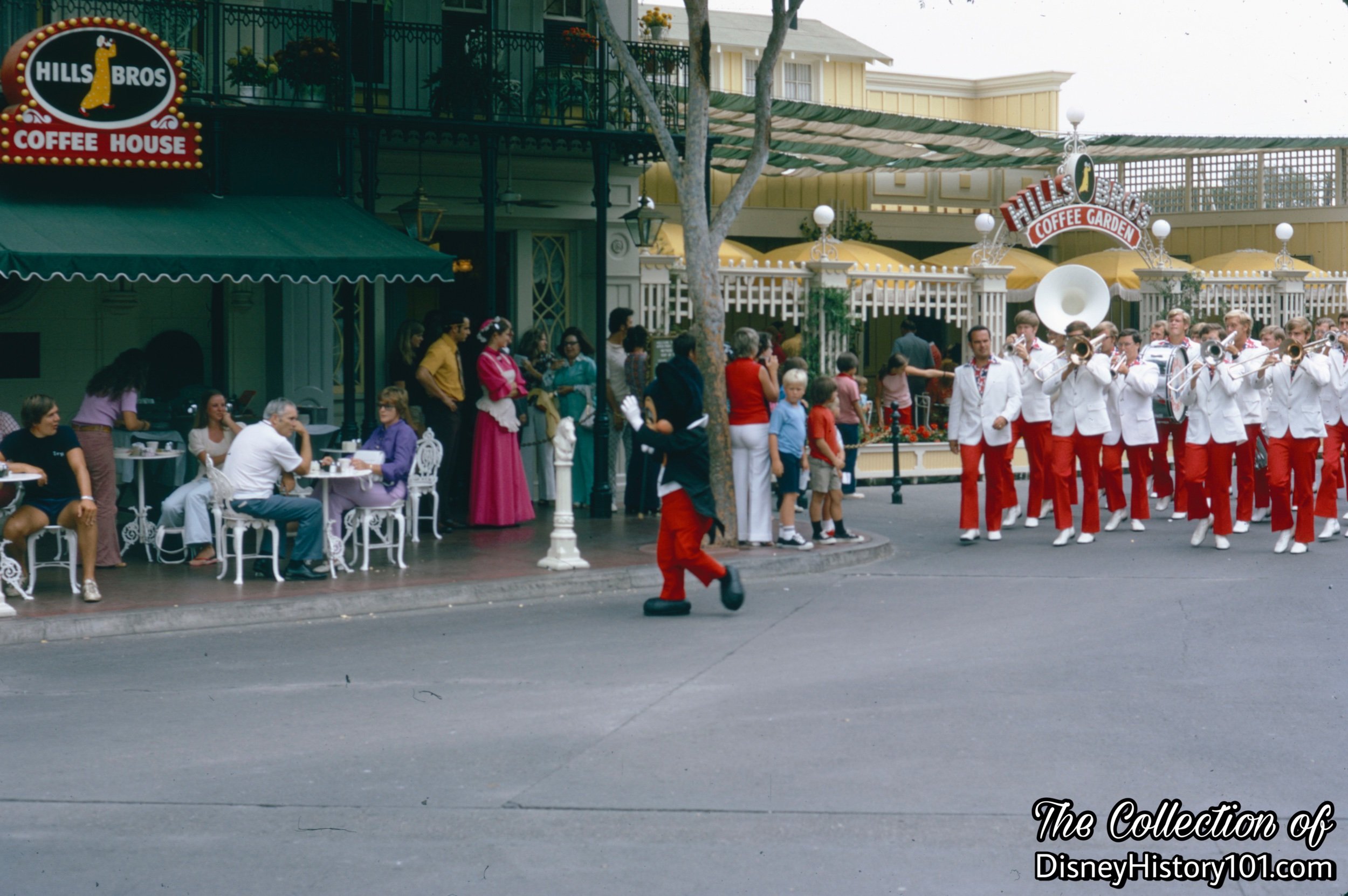
Hills Bros. Coffee House and Coffee Garden, 1973.
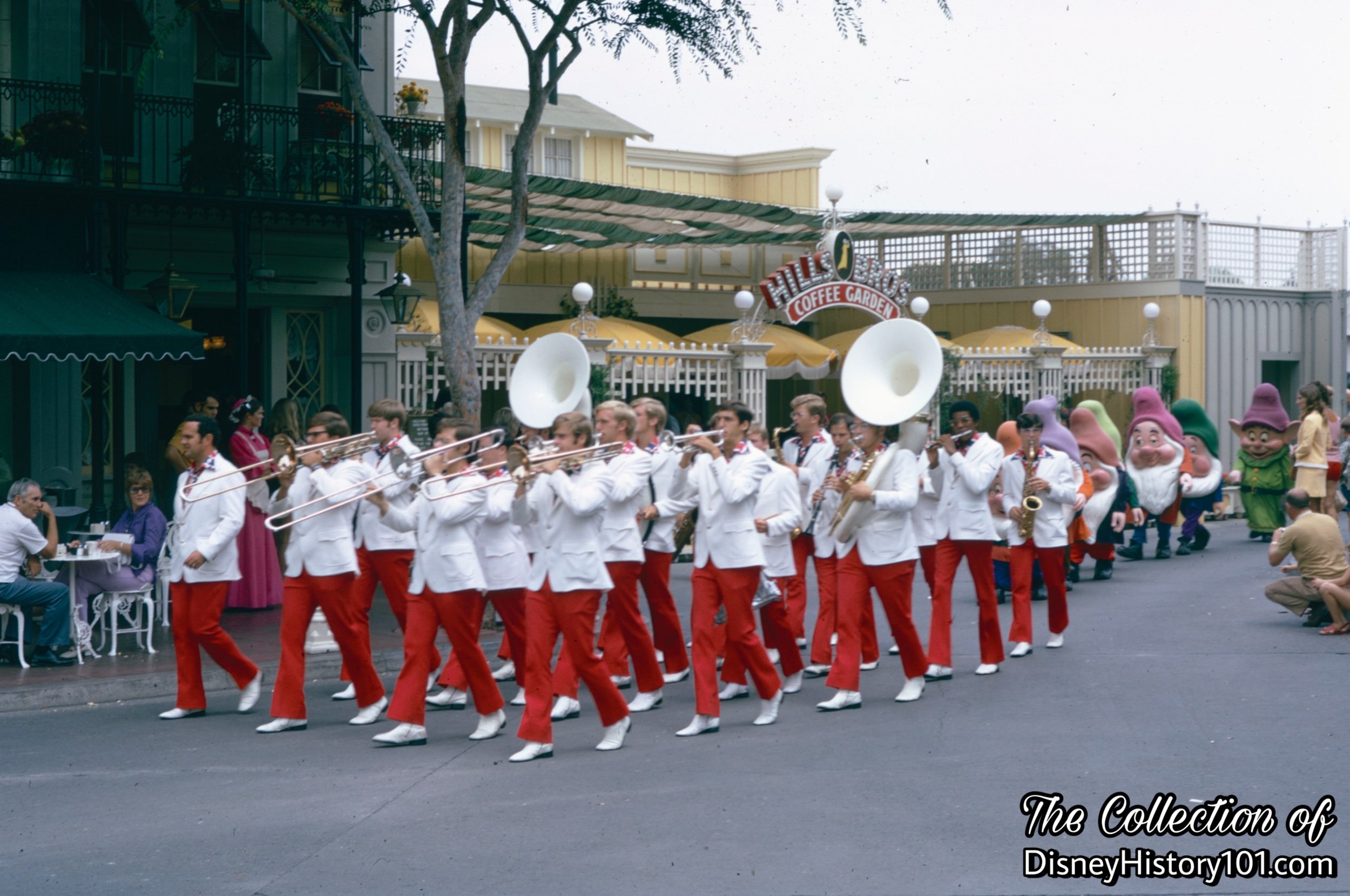
Hills Bros. Coffee House and Coffee Garden, 1973.

Hills Bros. Coffee House and Coffee Garden, 1973.
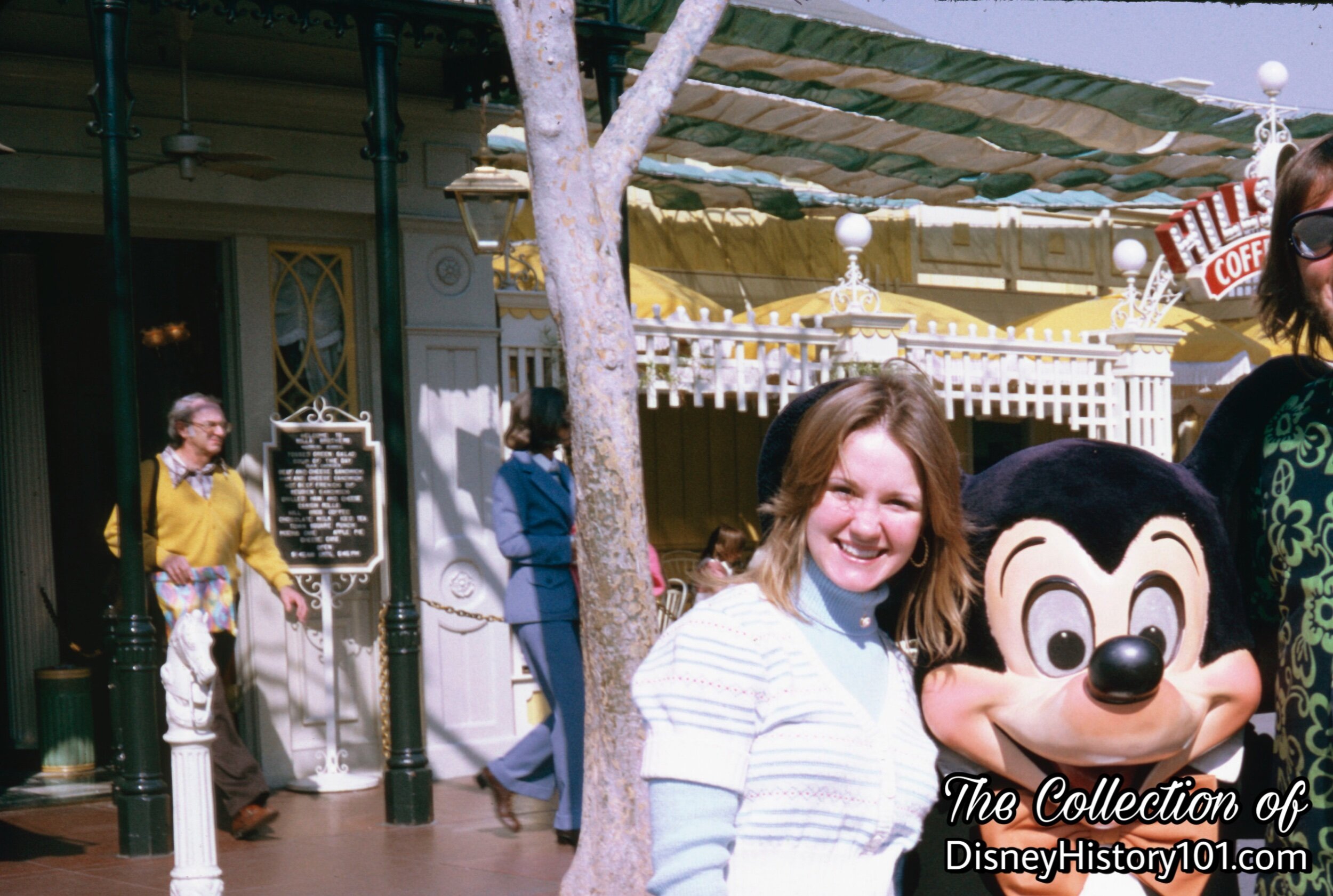
Hills Bros. Coffee House and Patio Behind Guest
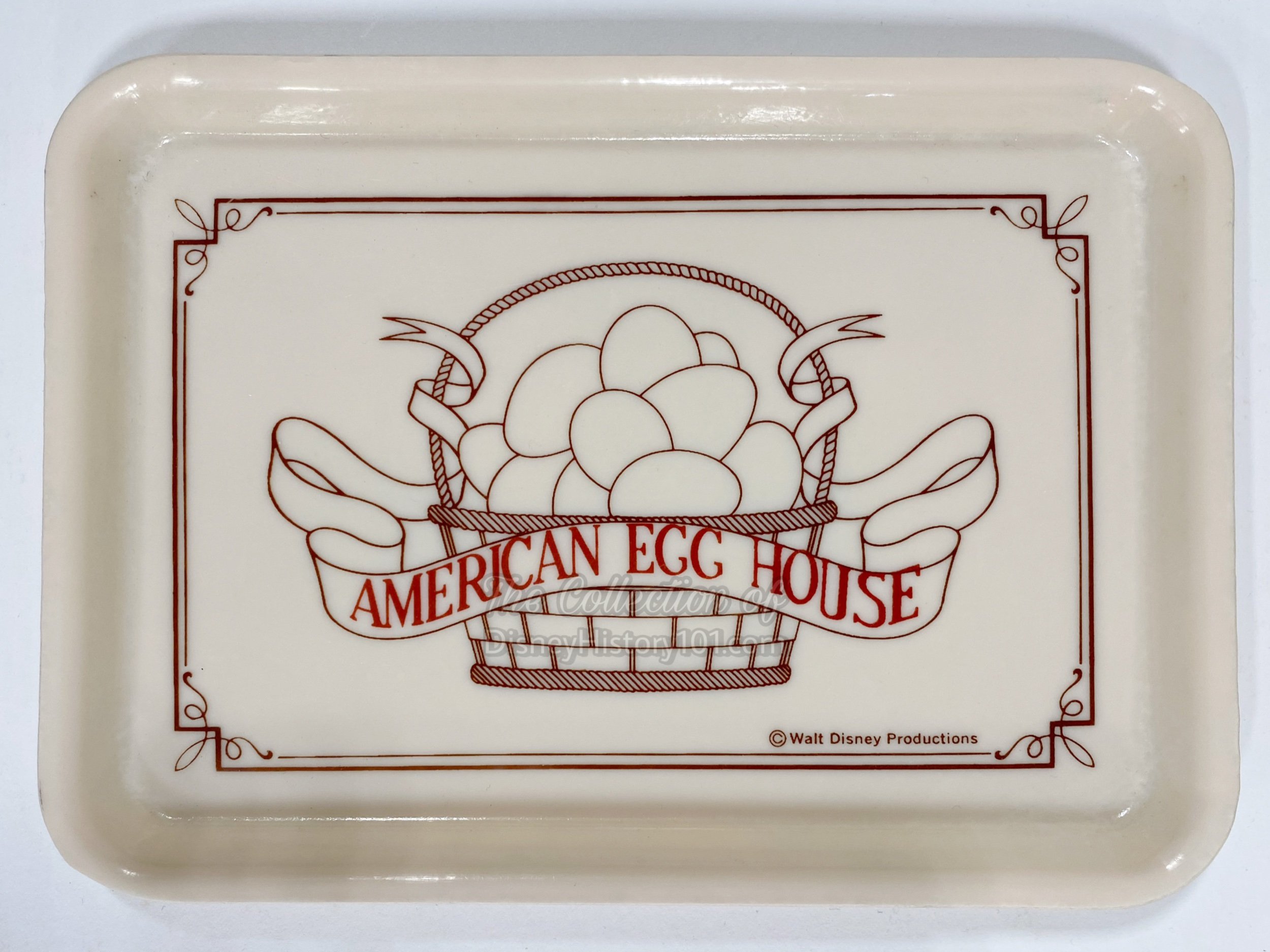
An American Egg House Tip Tray by Camtray of Huntington Beach.
(July 14, 1978 - September 30, 1983)
The American Egg House (presented by the newest Disneyland Participant - the American Egg Board) opened next door to the Disney Showcase on Friday, July 14th, 1978. The restaurant was renowned for its Victorian Decor, Demonstration Chef, and Breakfast and Lunch Menus.
Much like its predecessor, the new restaurant offered table service in the dining room and on the patio and was open for breakfast, lunch, and dinner. The Grand Opening Ceremonies included culinary demonstrations by World Champion Omelet Maker - Chef Howard Helmer (of the American Egg Board), who prepared 217 two-egg omelets in 30 minutes, breaking the previous Guinness World Record of 188. [Disneyland LINE, July 20, 1978]
The American Egg Board advertised the highlight of their menu this way : “Eggs are nature’s most nearly perfect food. Low in calories and high in protein, eggs are economical - especially important in preparing nutritious meals at low cost. Eggs are versatile, too. They’re good at any time of the day…in an elegant soufflé or a quick and easy omelet…delicious any way you fix them. The Incredible Edible Egg - a natural wonder incredibly good so many different ways.” By 1981, the restaurant offered a few sandwiches, but their predominant focus was on egg-related dishes - the American Egg House Deluxe
Two Large Farm Fresh Eggs or Eggs and Steak (served any style), the Omelet Extraordinaire, Egg Salad Sandwich, California Omelet, the Spanish Omelet, the Omelet Delight, Egg Sandwich Supreme, Eggs Benedict, The American Egg Burger, Grilled Steak and Cheese Omelet, and the American Egg Burger (one fried egg on Canadian bacon, topped with American cheese, tomato and mushrooms, served in a sesame seed bun). Even the “Luncheon and Dinner Menu” offered many egg options - omelets, salads, sandwiches, quiches, merengues, and custards containing healthy American eggs.
A particularly popular specialty beverage was “The Instant Egg Pick-up” - “a blend of fresh egg, orange juice, and honey”! There were also plenty of Belgian waffle menu options as well as fruit dishes which included grapefruit, fresh melon, strawberries, fresh orange juice and tomato juice. Pastries and baked goods offered included warm danishes, blueberry muffins, English muffins, cherry pie a La mode, strawberry and ambrosia crepe, and cheesecake with strawberry topping.
In 1981, the American Egg House with its Victorian decor, demonstration chef, and breakfast and lunch menus produced $518,000 in revenue for Main Street Food. This was owning to VIPs of Disneyland (guests), its Main Street Foods hosts and hostesses (totaling 176 summer/118 fall), two Main Street Foods Stage Supervisors, and Main Street Foods Area Stage Supervisor.
Ultimately, Disneyland Participant Affairs and Disneyland Participant and Lessee American Egg Board could not negotiate a new cooperative agreement to maintain their ongoing relationship regarding this Location, so the two “reliable firms parted ways.” Though there were three sponsors in this location since 1955, the American Egg House would live on when this location would be referred to as the “Egg Gate.”
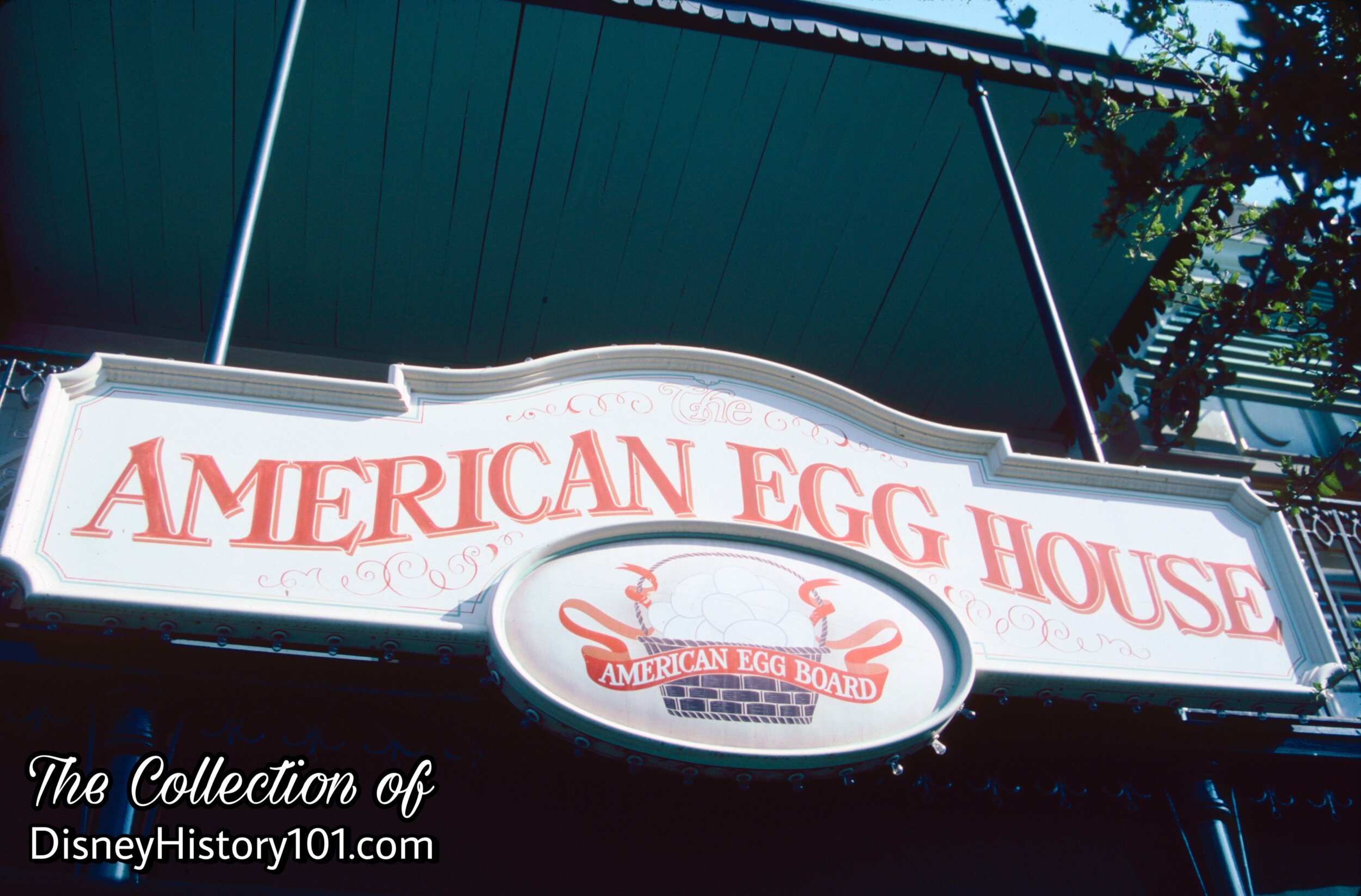
American Egg House, (September, 1983)
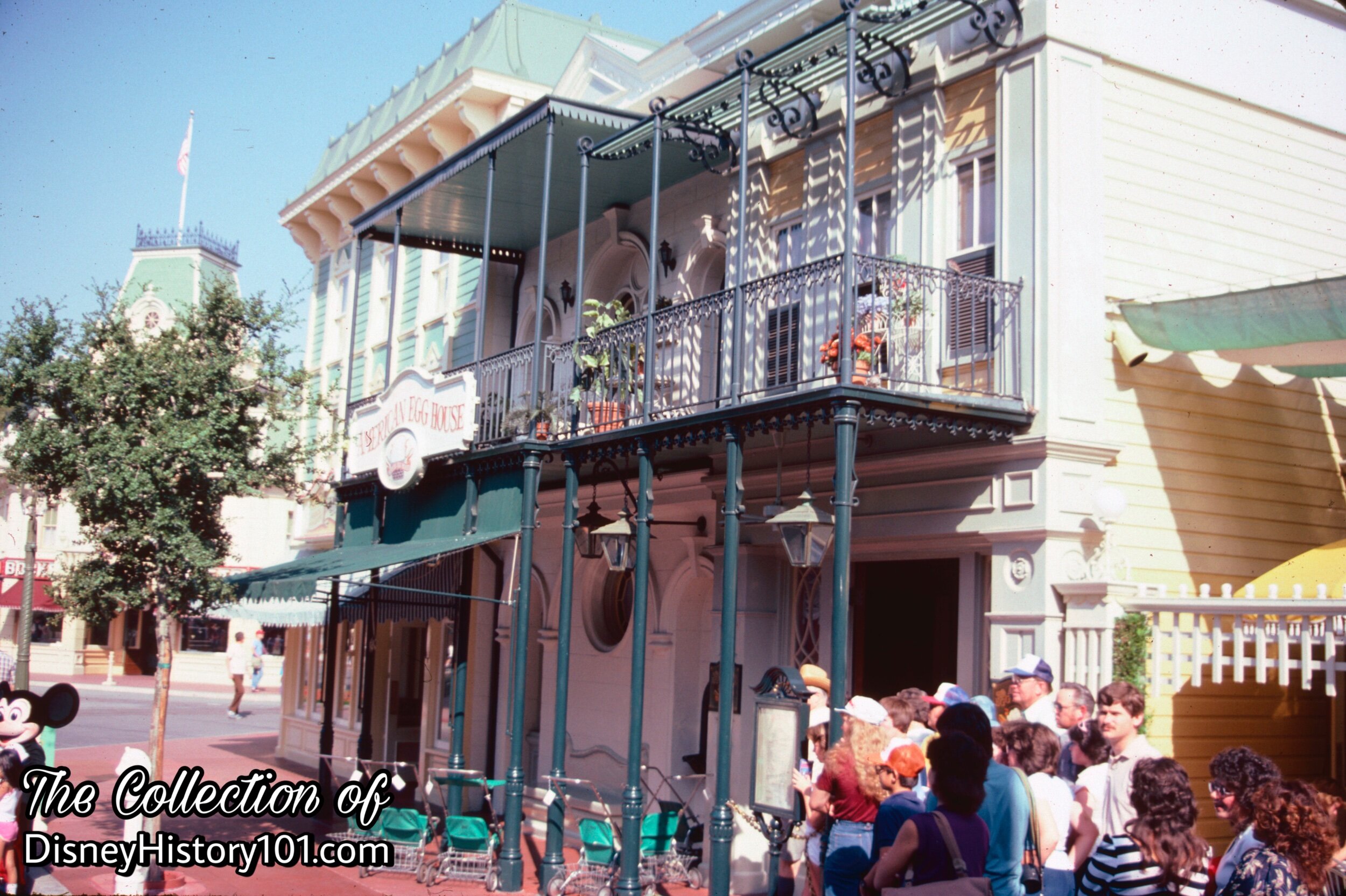
American Egg House, (September, 1983)

Guests at American Egg House
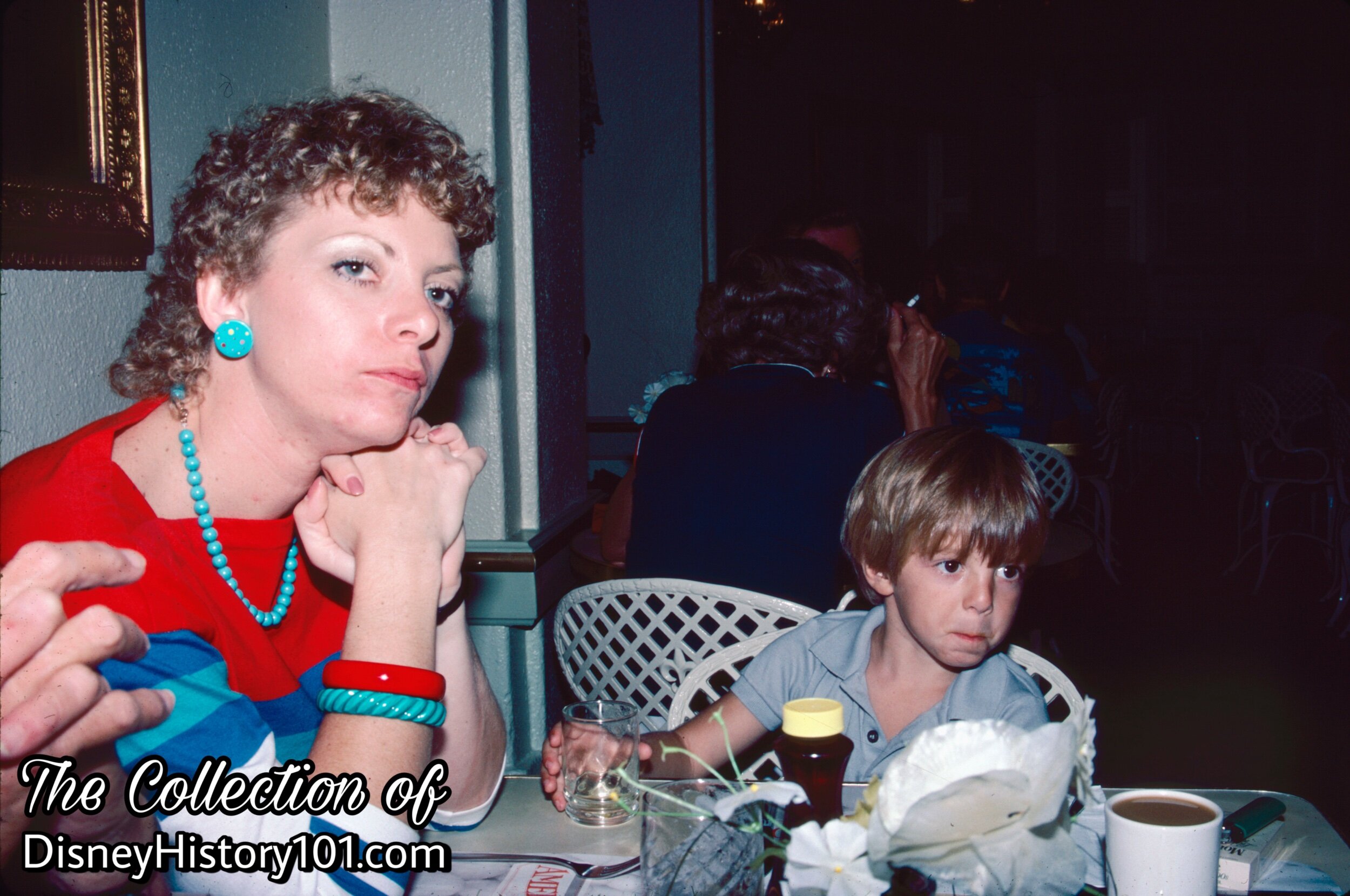
Guests at American Egg House
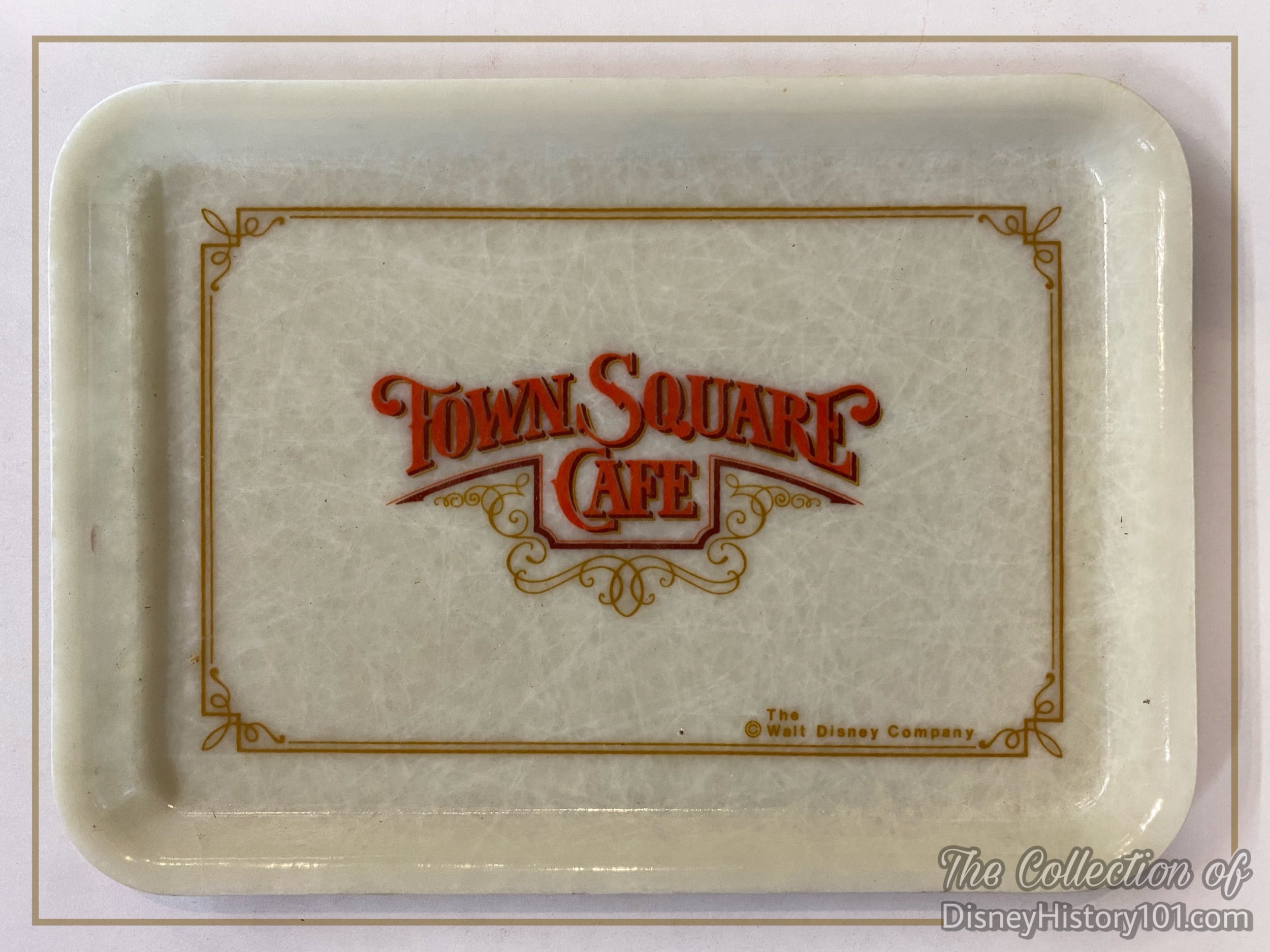
A Town Square Cafe Tip Tray.
Town Square Cafe (winter, 1976 - spring, 1978)
The first incarnation of Town Square Cafe opened for lunch and dinner with a number of omelets - Omelet Extraordinaire (three farm fresh eggs, ham, American cheese, mushrooms, green onions, and chili salsa), the California Omelet (three farm fresh eggs, sliced avocado, diced tomato, alfalfa sprouts, sour creme, and pine nuts), the Spanish Omelet (three farm fresh eggs, diced tomato, green Ortega chilis, Spanish sausage, green onions and cheese), and the Omelet Delight (three farm fresh eggs, ham, and American cheese)! Town Square Cafe also offered salads including the Seafood Louis (with pink shrimp, tuna, crisp greens, Louis dressing, hard-boiled egg, and lemon wedges). Other offerings included several choices of burgers (Ortega Cheese, Avocado and Bacon, Bacon Cheese, and the Original Hamburger Platter), the Fire House Favorite hot dog, a couple of sandwiches (Steak Sandwich and the Club Sandwich), desserts (Apple Pie, Cherry Pie, Cheesecake with cherry topping, Cinema Sundae), and plenty of beverages (including coffee, soft drinks, tea, hot cocoa, and milk).
Town Square Cafe (October 1, 1983 - August 23, 1992)
The new Town Square Cafe restaurant offered table waitress service, and was “a great place for breakfast and lunch with a menu featuring eggs, omelets, hamburgers, specialty sandwiches, salads, and desserts.” In addition, healthier menu options - Chicken Breast Sandwich, Chef’s Salad, Seafood Louis, and Omelettes with less cholesterol - were now available to guests! The Town Square Cafe occasionally hosted special events, like Private Parties (e.g. GM and Hughes Employees, January of 1986).
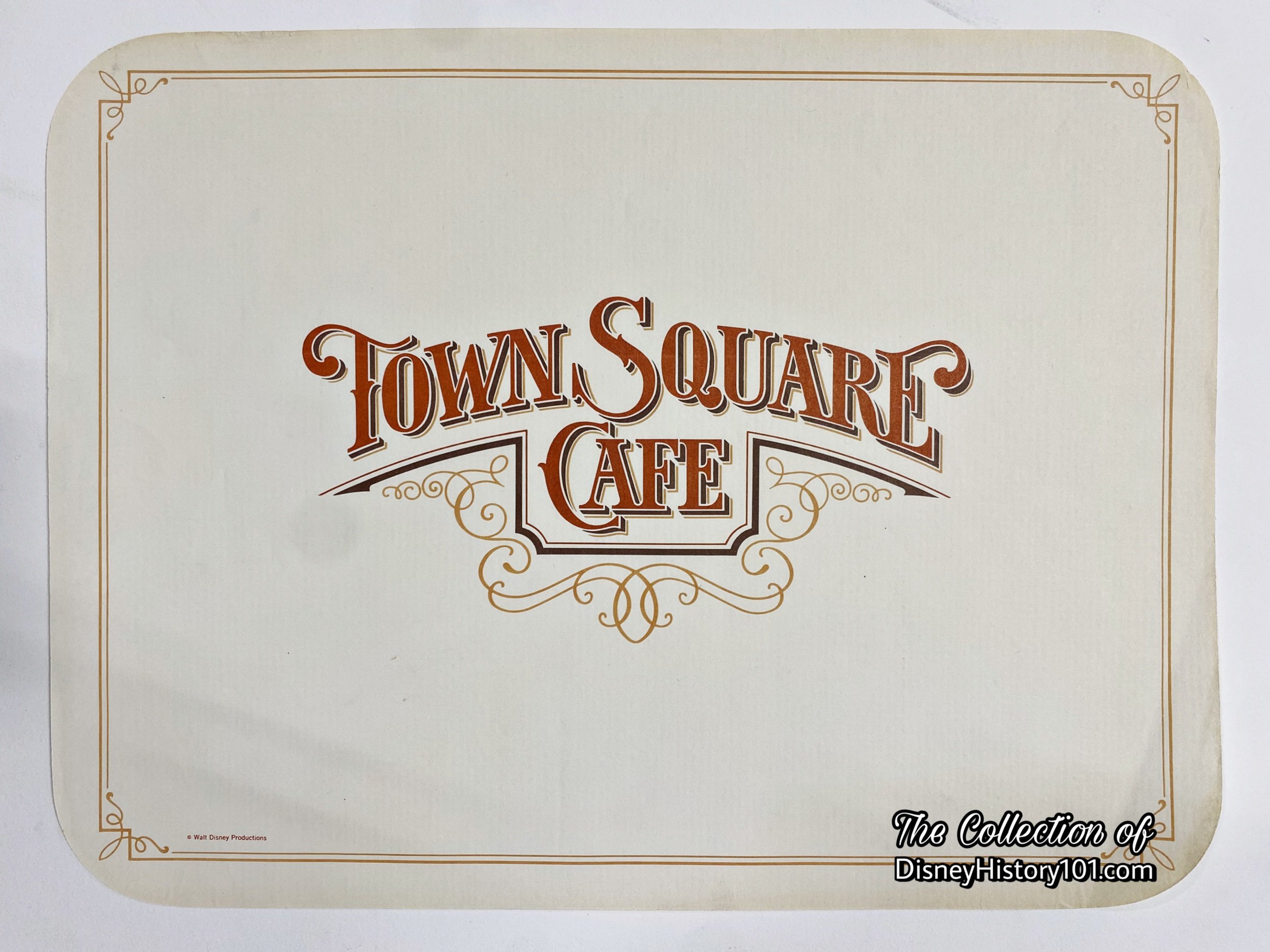
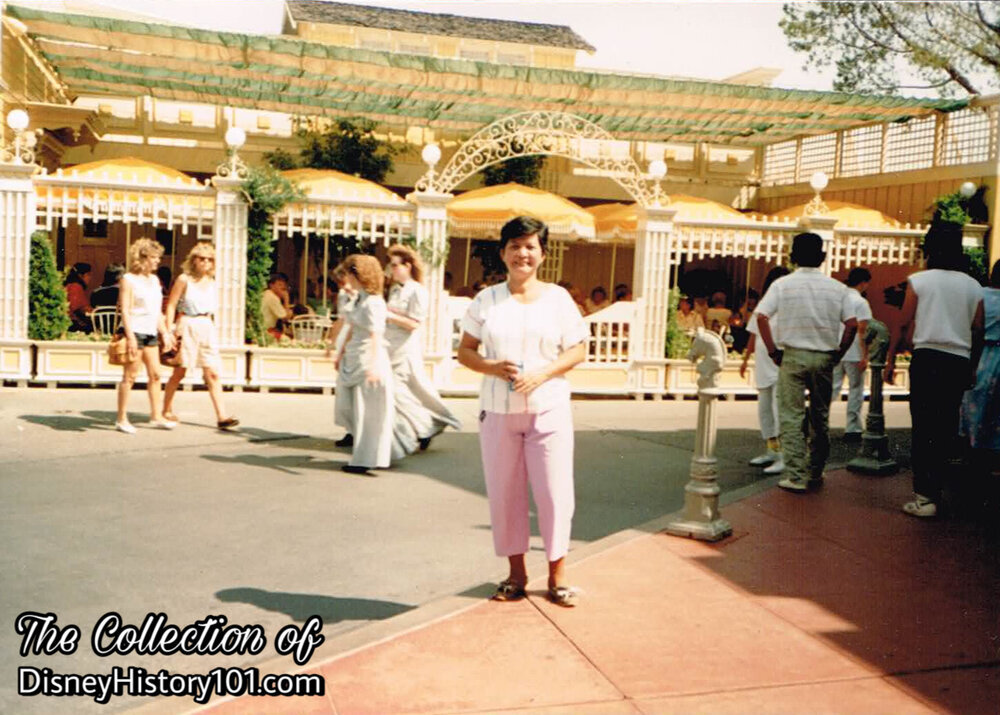
A Guest in front of the Town Square Cafe Patio
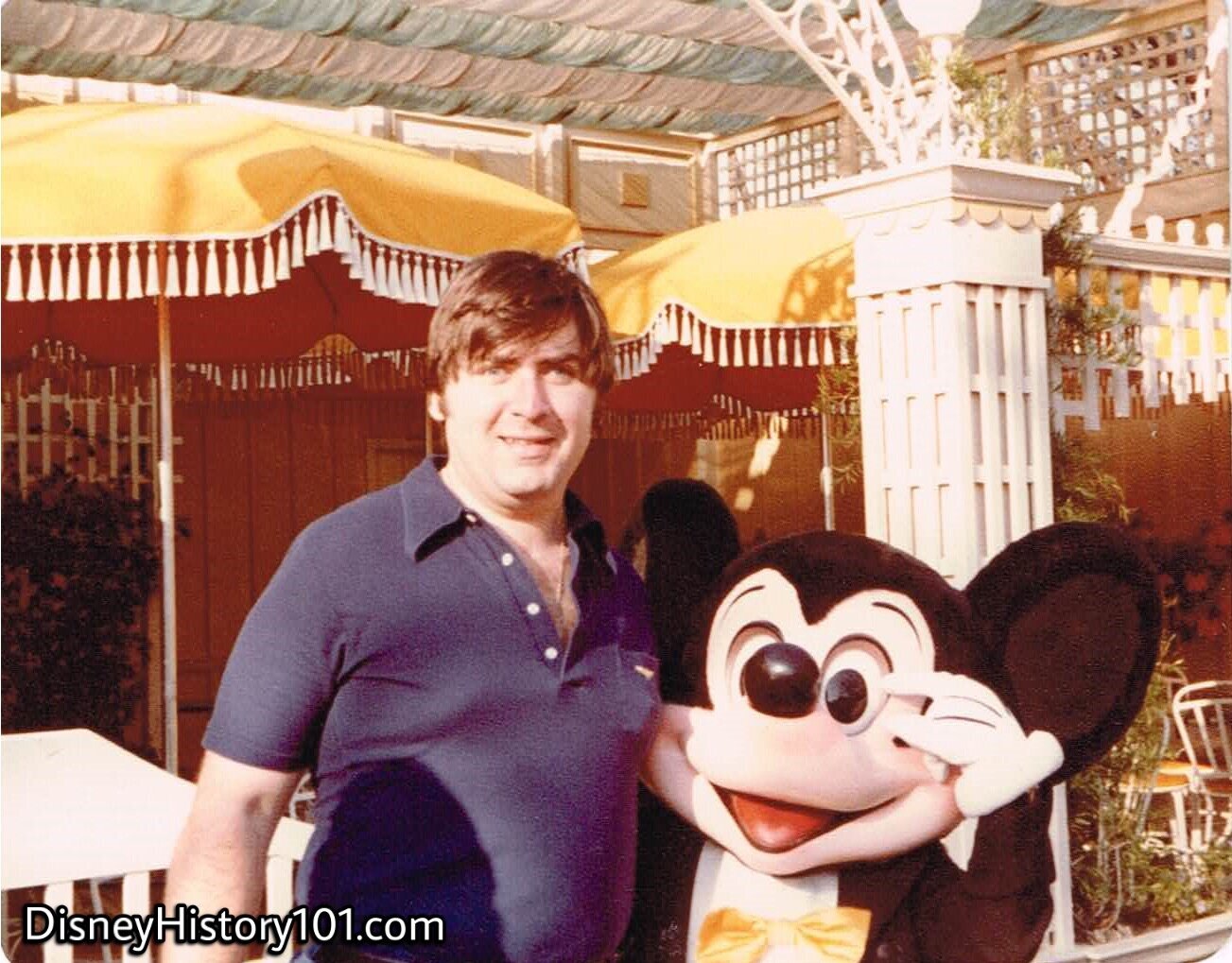
Mickey Mouse and a Guest Near the Town Square Cafe Patio
The Disney Characters often walked close-by the Town Square Cafe Patio.
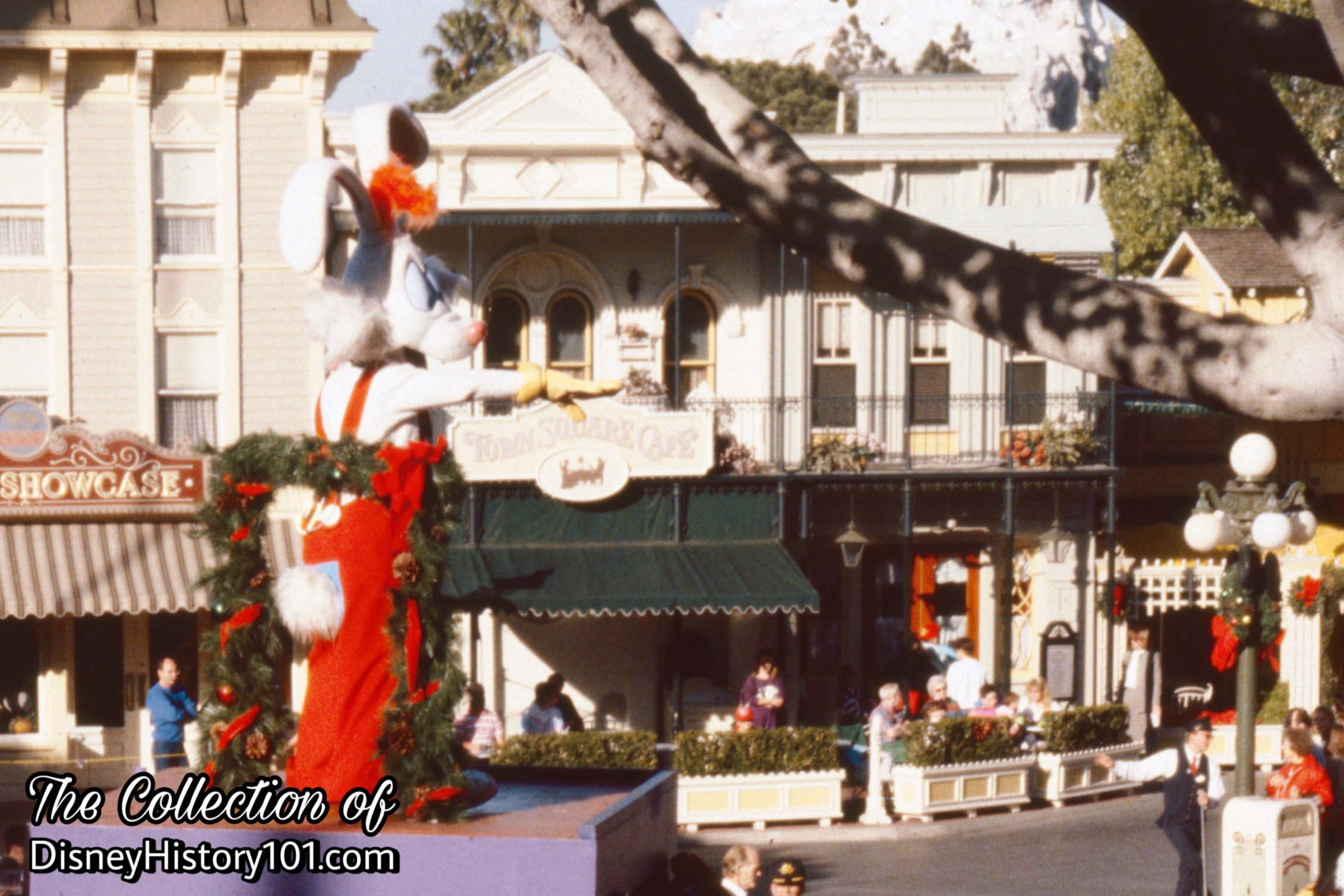
Parade floats pass the guests of Town Square Cafe before heading Backstage.
The Town Square Cafe Patio also offered a fantastic view of parade units (as in this Vintage View which may have preserved a moment of Roger Rabbit’s very first Christmas, during December of 1988). Through the years, Parade Units would often headed from the “Parade Formation Area” and out of the old Hills Bros. Gate (also known as the Egg House Gate).
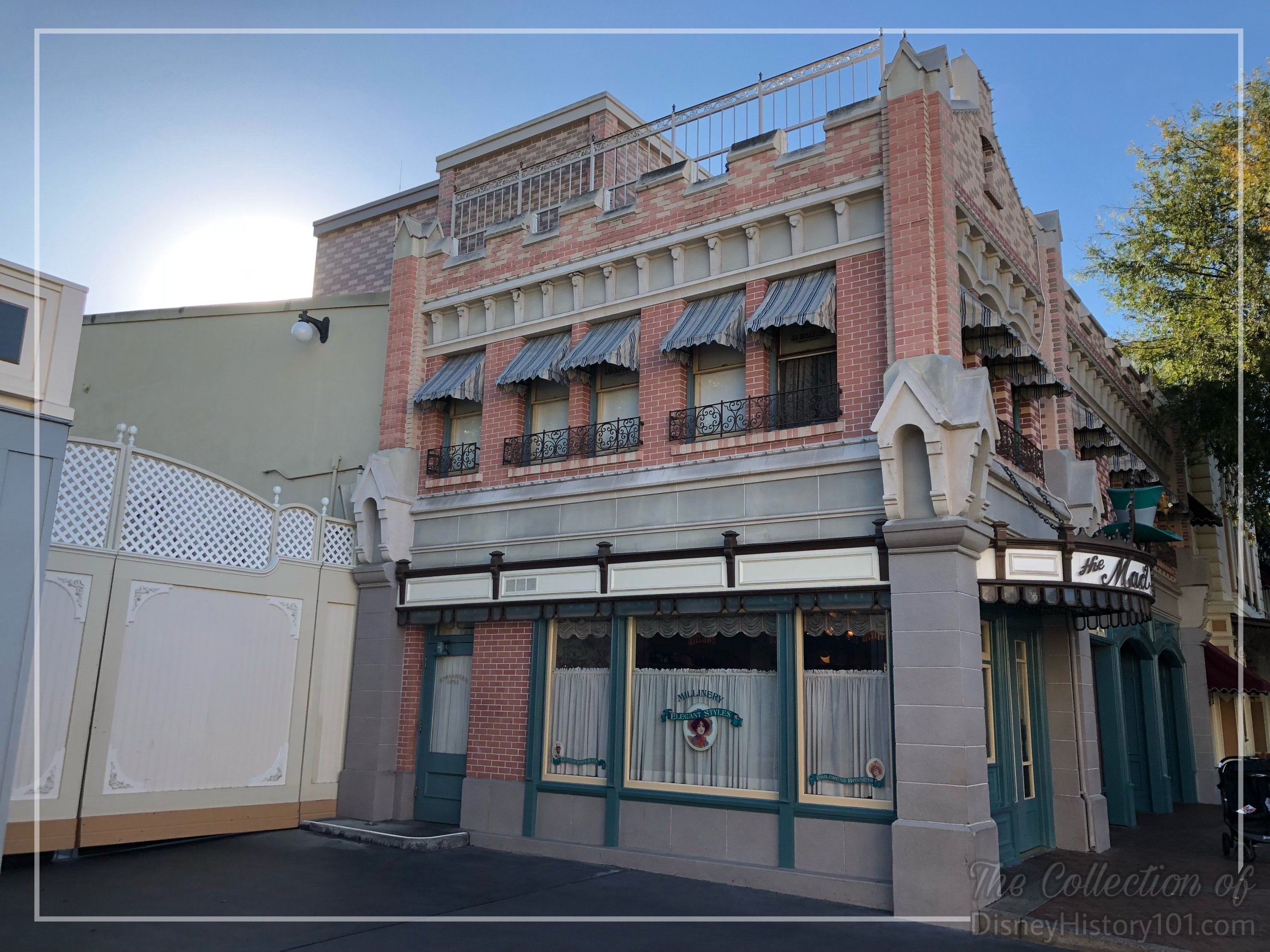
The view of the Mad Hatter and “Egg House Gate” (left) from the site of the former Maxwell House Coffee Garden.

The Disneyland News, February 10, 1956, page 12.

